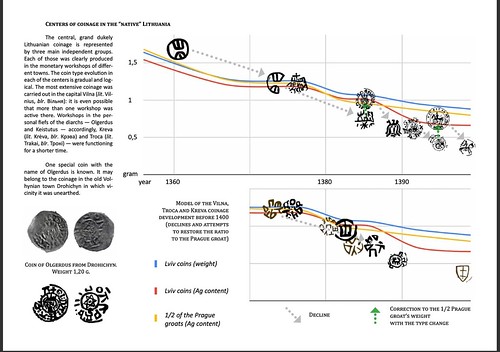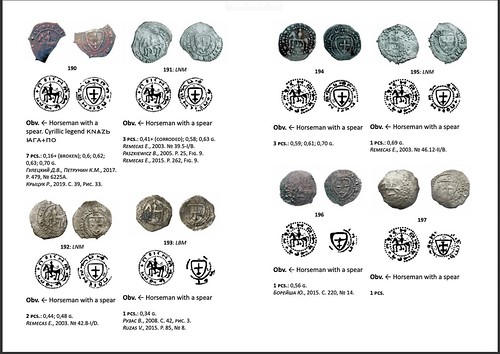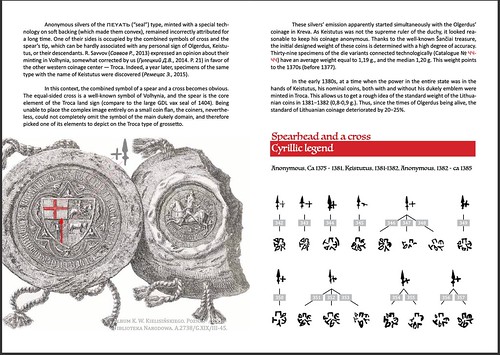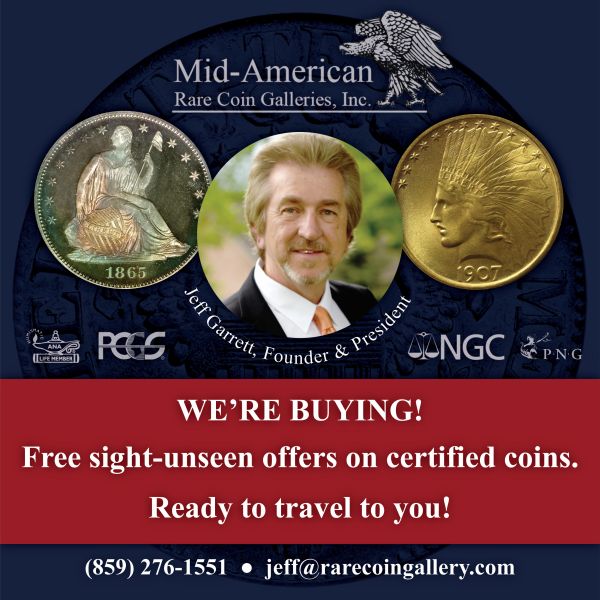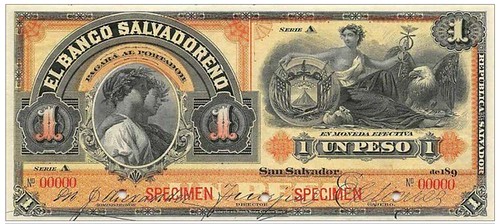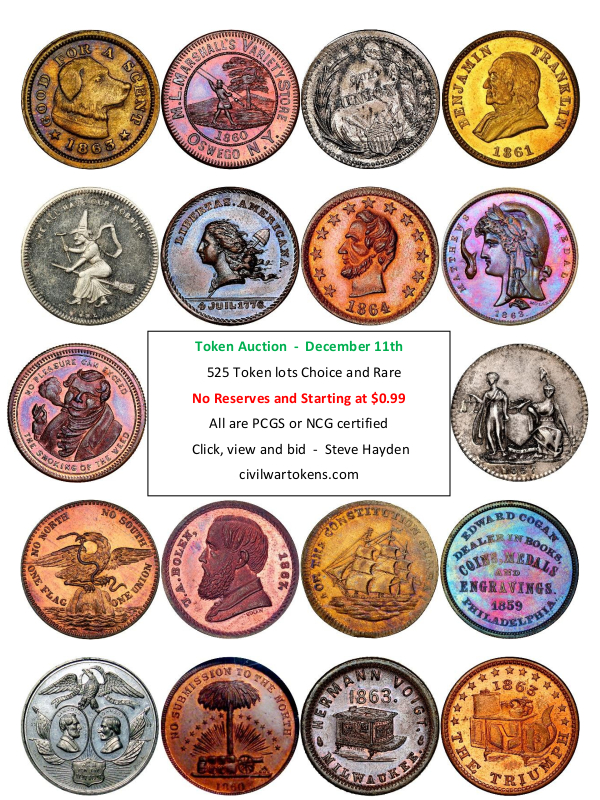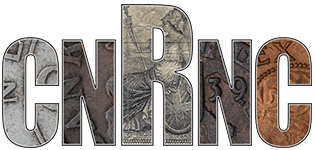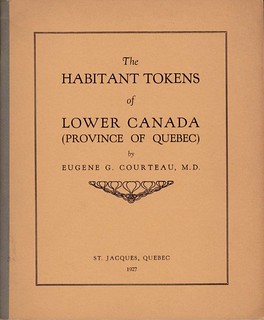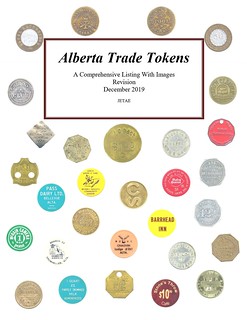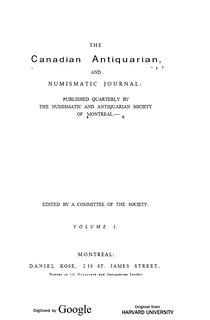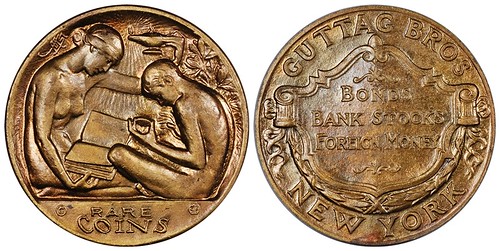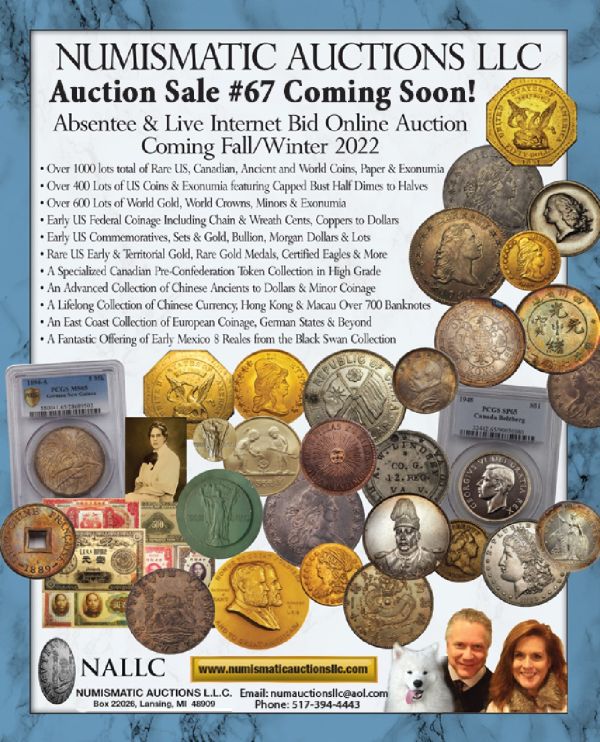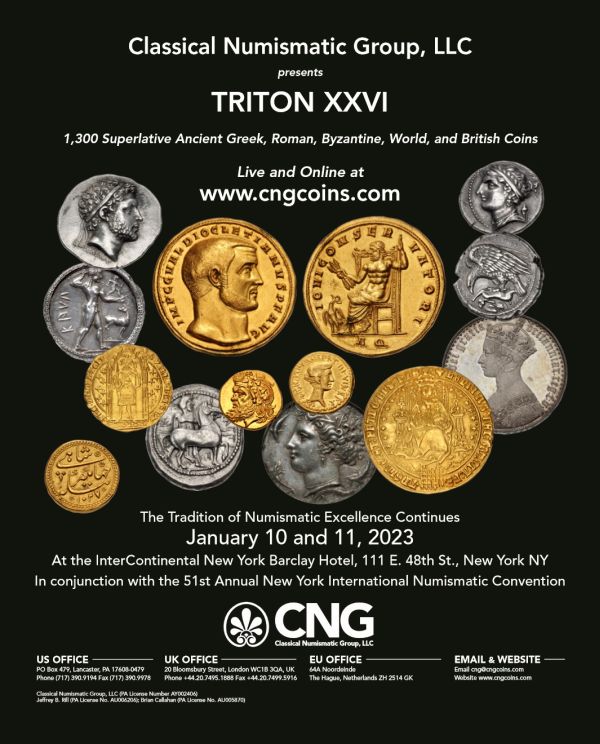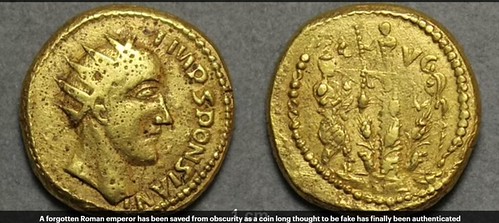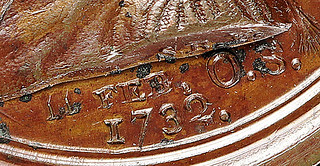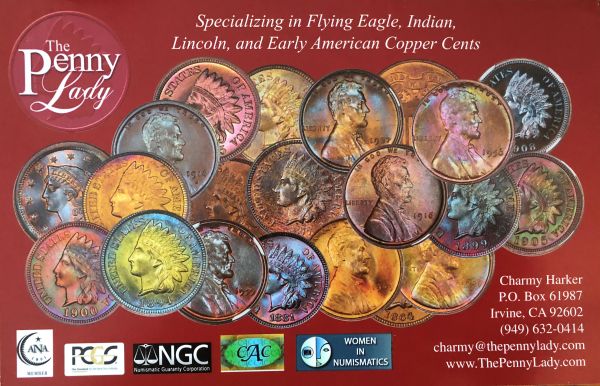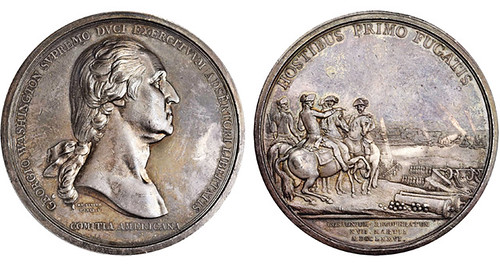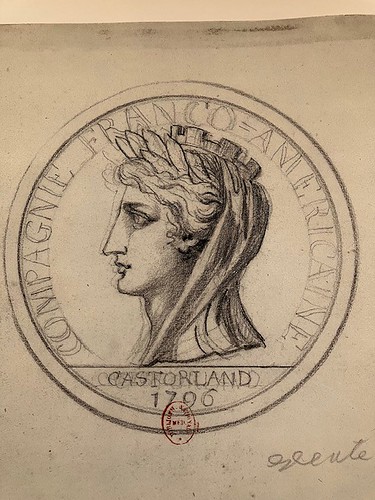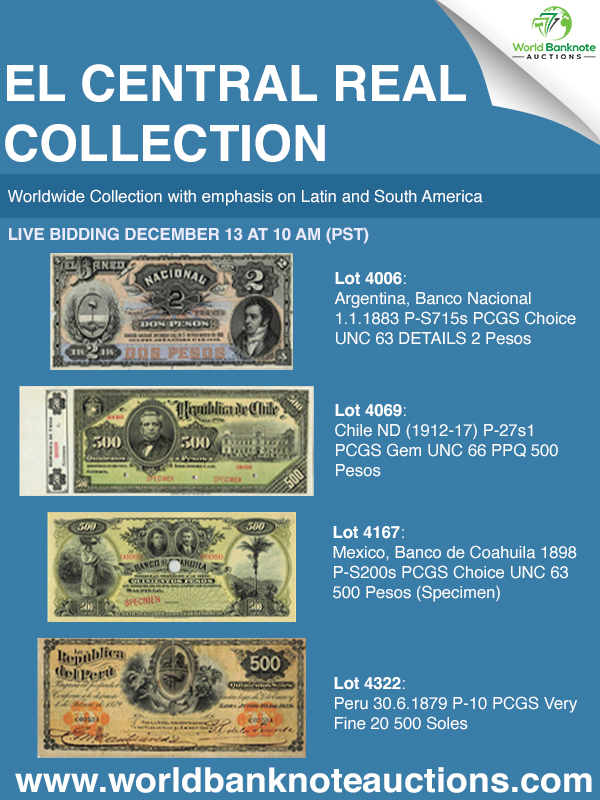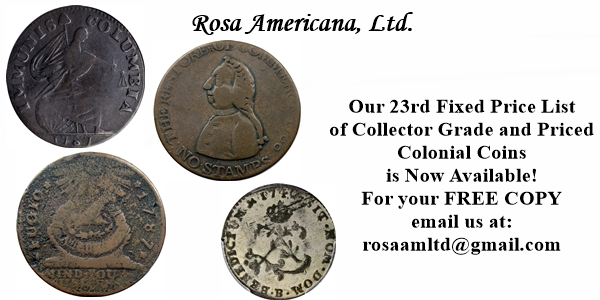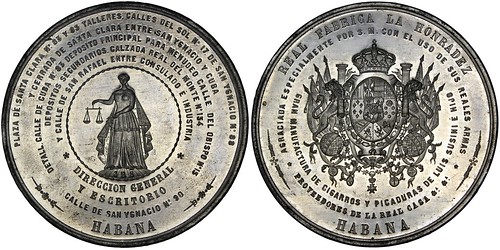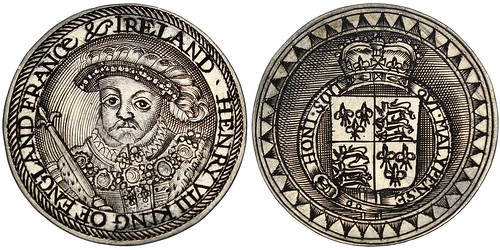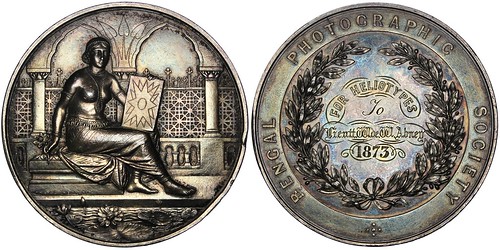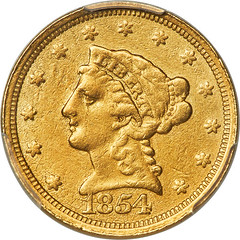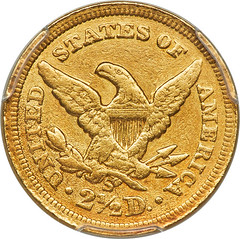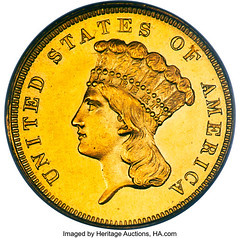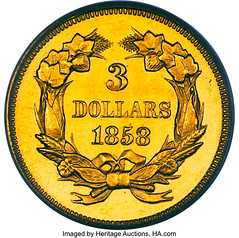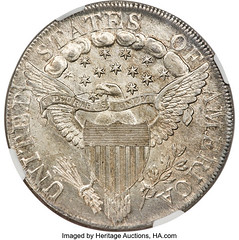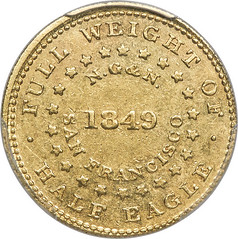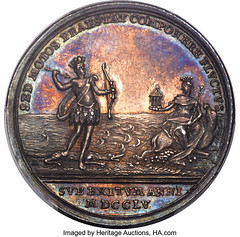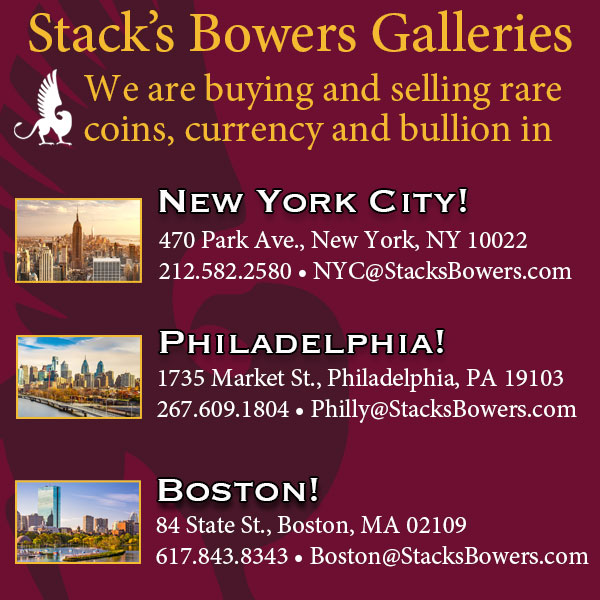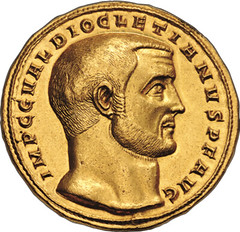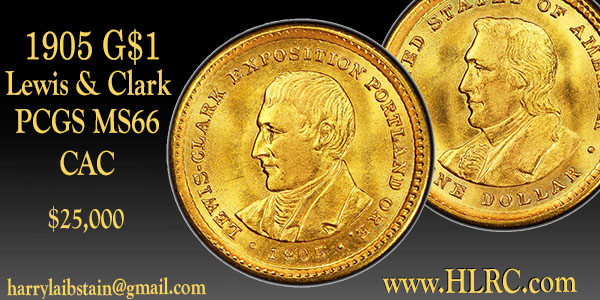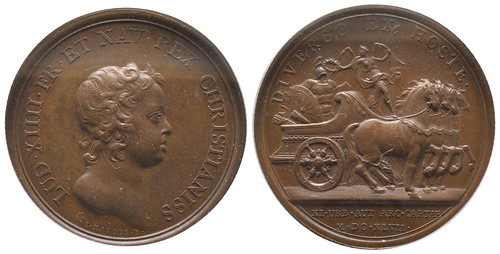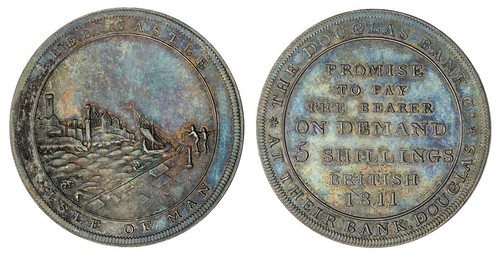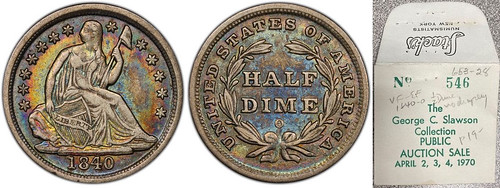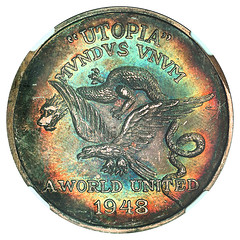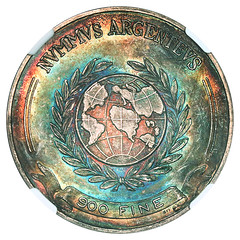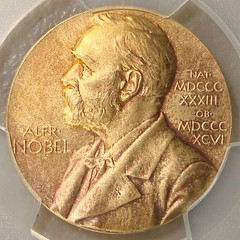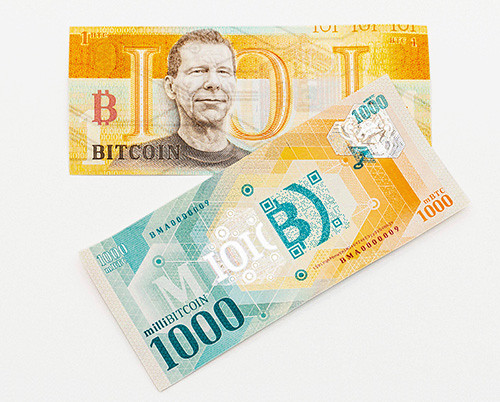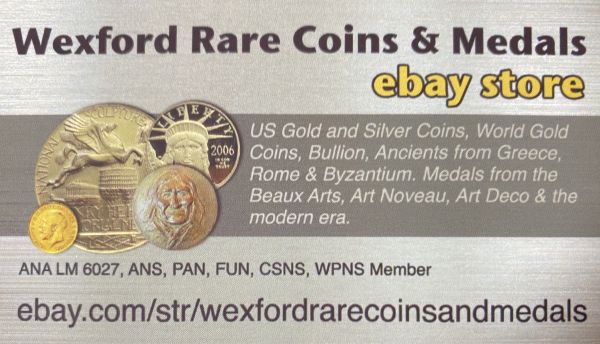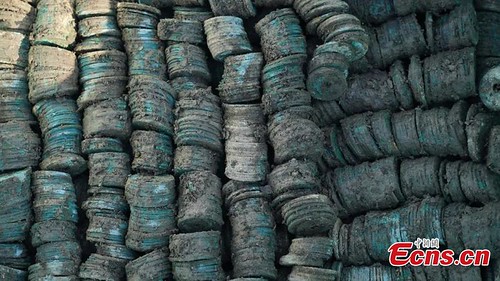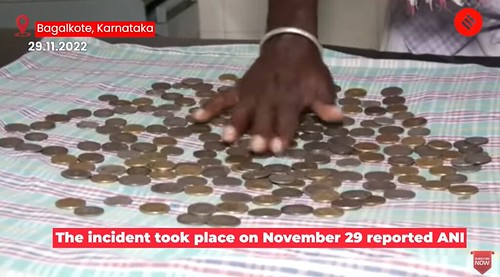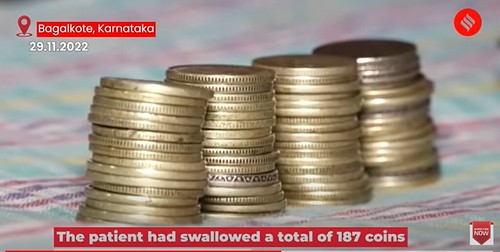
Visit our NBS Sponsors




About UsThe Numismatic Bibliomania Society is a non-profit association devoted to the study and enjoyment of numismatic literature. For more information please see our web site at coinbooks.org SubscriptionsThose wishing to become new E-Sylum subscribers (or wishing to Unsubscribe) can go to the following web page link MembershipThere is a membership application available on the web site Membership Application To join, print the application and return it with your check to the address printed on the application. Print/Digital membership is $40 to addresses in the U.S., and $60 elsewhere. A digital-only membership is available for $25. For those without web access, write to: Charles Heck, Treasurer AsylumFor Asylum mailing address changes and other membership questions, contact Chuck at this email address: treasurer@coinbooks.org SubmissionsTo submit items for publication in The E-Sylum, write to the Editor at this address: whomren@gmail.com BUY THE BOOK BEFORE THE COINSale Calendar |
- WAYNE'S WORDS: THE E-SYLUM DECEMBER 4, 2022
- NEW BOOK: COINS OF ENGLAND PRE-DECIMAL, 58TH ED.
- NEW BOOK: COINS OF ENGLAND DECIMAL ISSUES, 9TH ED
- NEW BOOK: LITHUANIAN GRAND DUCAL COINS
- BANKNOTE BOOK EL SALVADOR CHAPTER
- NEW BOOK: BILLIONENSCHEINE
- NEW BOOK: LA COTE DES BILLETS DE LA R.C.F.T.O.
- WEBSITE: CANADIAN NUMISMATIC RESOURCES
- E-SYLUM SUBSCRIBER CONTEST REMINDER
- ANDREW W. HARKNESS (1934-2022)
- ROBERT W. RIGHTMIRE (1940-2022)
- NNP ADDS NOVEMBER 2022 SYMPOSIUM VIDEOS
- VIDEO: DAN BROWN
- EARLY WORLD PAPER MONEY PUBLICATIONS SOUGHT
- NOTES FROM E-SYLUM READERS: DECEMBER 4, 2022
- A DUVIVIER PUZZLER
- ANA OPENS 2023 AWARD NOMINATIONS
- ANA SEEKS NEW EDUCATION DIRECTOR
- VOCABULARY TERM: MEDAL MANUFACTURING
- HAPPY 100TH BIRTHDAY, KAY LENKER!
- THE CHESTER L. KRAUSE LEGACY PARK
- NUMISMAGRAM MEDAL SELECTIONS: DECEMBER 4, 2022
- HERITAGE DECEMBER 2022 HIGHLIGHTS
- CNG TRITON XXVI AUCTION ANNOUNCED
- NUMISMATIC NUGGETS: DECEMBER 4, 2022
- MEDIEVAL COINS OF DEFUNCT DYNASTIES
- MASSIVE SONG DYNASTY HOARD FOUND IN CHINA
- GOLD ‘THREE PAGODA COINS' FOUND IN INDIA
- NORWEGIAN NUMISMATIC ASSOCIATION SCHIVE MEDAL
- HISTORY OF THE AMERICAN CASH REGISTER
- HISTORY OF THE SAFE DEPOSIT BOX
- LOOSE CHANGE: DECEMBER 4, 2022
- HOSPITAL PATIENT'S BELLYACHE: 187 COINS
Click here to read the thin version on the web
Click here to subscribe
Click here to access the complete archive
To comment or submit articles, reply to whomren@gmail.com
Content presented in The E-Sylum is not necessarily researched or independently fact-checked, and views expressed do not necessarily represent those of the Numismatic Bibliomania Society.
WAYNE'S WORDS: THE E-SYLUM DECEMBER 4, 2022
 New subscribers this week include:
Anne Burke, courtesy of John Ferreri;
Joanna Marrin, courtesy of Yossi Dotan; and
Wayne Davis.
Welcome aboard!
New subscribers this week include:
Anne Burke, courtesy of John Ferreri;
Joanna Marrin, courtesy of Yossi Dotan; and
Wayne Davis.
Welcome aboard!
Remember, we're running a contest with a $100 first prize to see who can supply the largest number of new subscribers. See the article elsewhere in this issue for details. This is not a drawing where random winners are picked - the winners will be those who supply the largest number of email addresses not already on our list.
This week we open with six new books, a great new website, two obituaries, updates from the Newman Numismatic Portal, and a Duvivier puzzle.
Other topics this week include the coins of England, El Salvador paper money, dealer Dan Brown, early world paper money publications, ANA news, medal makers, Kay Lenker, Chet Krause, cash registers, and safe deposit boxes.
To learn more about Lithuanian Grand Ducal coins, Canadian Numismatic Resources, Agricultural and Mechanical Society medals, the Guttag Brothers, the Manly medal, the newest numismatic centenarian, the Chester L. Krause Legacy Park, the 1755 Safety at Sea medal, 'Three Pagoda' coins and Louis the Lazy, read on. Have a great week, everyone!
Wayne Homren
Editor, The E-Sylum
NEW BOOK: COINS OF ENGLAND PRE-DECIMAL, 58TH ED.
SPINK published a new edition of the classic work on the pre-decimal coins of England. -Editor
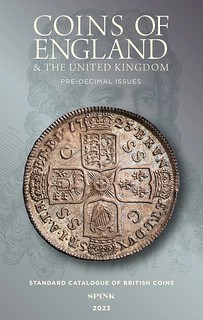 Coins of England & the United Kingdom 2023, Pre-Decimal Issues, 58th edition
Coins of England & the United Kingdom 2023, Pre-Decimal Issues, 58th edition
Regular price £35.00
Hardback / 216 x 138mm
640 pages with colour illustrations throughout
This historic reference work for British coins is still the only catalogue to feature every major coin type from Celtic to the Decimal coinage of Queen Elizabeth II, arranged in chronological order and divided into metals under each reign, then into coinages, denominations and varieties. All decimal coinage since 1968 is listed in a separate volume, available as an independent publication.
The catalogue includes up-to-date values for every coin, a beginner's guide to coin collecting, numismatic terms explained and historical information about each British coin, from our earliest (Celtic) coins, Roman, Anglo-Saxon and Norman coins, the coins of the Plantagenet Kings, the Houses of Lancaster and York, the Tudors and Stuarts, to the more modern Milled coinage, minted for the first time in 1561 during the reign of Elizabeth I.
From the earliest of times, coins have been used by states or monarchs to communicate with people; Coins of England is therefore not only a reference book for collectors, but a fascinating snapshot of British history, illuminating its economics, technology, art, politics and religion. Over 4,000 price changes have been made in this edition to reflect market activity during the past year.
ALSO AVAILABLE AS A DOWNLOADABLE PDF
For more information, or to order, see:
Coins of England & the United Kingdom 2023, Pre-Decimal Issues, 58th edition
(https://spinkbooks.com/products/coins-of-england-the-united-kingdom-2023-pre-decimal-issues)
NEW BOOK: COINS OF ENGLAND DECIMAL ISSUES, 9TH ED
SPINK also published a new edition of the companion work on the decimal coins of England. -Editor
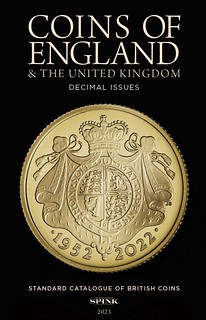 Coins of England & the United Kingdom 2023, Decimal Issues, 9th edition
Coins of England & the United Kingdom 2023, Decimal Issues, 9th edition
Regular price £15.00
Hardback / 216 x 138mm
400 pages with colour illustrations throughout
Coins of England and the United Kingdom Pre-Decimal and Decimal volumes comprise the Standard Catalogue of British Coins, with the decimal issues under Queen Elizabeth II and King Charles III listed in this separate volume.
The Decimal issue gives a comprehensive overview of all individual coins and sets issued by the Royal Mint since 1971 (and in circulation since 1968), offering an authoritative catalogue of modern British coins.
ALSO AVAILABLE AS A DOWNLOADABLE PDF
Literature dealer Charlie Davis adds:
"I will have a limited number of the two volumes available on December 29 at $55.00/$25.00 respectively." Visit his website at http://www.numisbook.com/ .
For more information, or to order, see:
Coins of England & the United Kingdom 2023, Decimal Issues, 9th edition
(https://spinkbooks.com/products/coins-of-england-the-united-kingdom-2023-decimal-issues)
NEW BOOK: LITHUANIAN GRAND DUCAL COINS
Dzmitry Huletski has published a new book on the medieval hammered Lithuanian Grand Ducal coins before 1401. -Editor
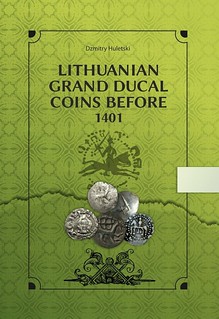 The first coins of the Grand Duchy of Lithuania are generally anonymous. This fact led to the difficulty of their perception by researchers for many years. Many types received the correct attribution in the last decade only; their metrological studies were virtually not carried out yet. However, it has now become obvious that coinage in the GDL began no later than in the 1370s, possibly even earlier. Stylistically and technologically, the first coins all carry an Eastern appearance, the legends are Cyrillic.
The first coins of the Grand Duchy of Lithuania are generally anonymous. This fact led to the difficulty of their perception by researchers for many years. Many types received the correct attribution in the last decade only; their metrological studies were virtually not carried out yet. However, it has now become obvious that coinage in the GDL began no later than in the 1370s, possibly even earlier. Stylistically and technologically, the first coins all carry an Eastern appearance, the legends are Cyrillic.
The word Lithuania was mentioned for the first time in the annals of Quedlinburg (year 1009) that the story of Saint Bruno of Querfurt who was beheaded by the pagans on the border of Lithuania and Rus'
. Mindowe (about 1200–1263) was the first well known Grand Duke of Lithuania and the only Christian King of Lithuania. The third quarter of the 14th century was marked for the Grand Duchy of Lithuania by unprecedented successes in foreign policy led by Grand Duke Olgerdus (1345–1377, lit. Algirdas, blr. Альгерд).
The territory of the state doubled due to the lands that were previously part of Kievan Rus'. Immediately before the establishment of Lithuanian power, many of these lands were under the rule of dukes from the Rurikid dynasty, some of whom were in varying degrees of dependence on the Golden Horde. Keistutus (lit. Kestutis, blr. Кейстут), who had power in the western wing of the state, is considered a diarch in relation to Olgerdus. The brothers jointly deprived of power in the state their brother Iaunutus back in 1345. After the death of Olgerdus, Keistutus accepted the supremacy of his son Iagal (lit. Jogaila, blr. Ягайла), but the disagreements of the dukes finally resulted in the short-term reign of Keistutus over the entire state (1381–1382). Ultimately, Iagal (Grand Duke of Lithuania in 1377–1434, later Wladyslaw II Jagiello, King of Poland in 1386–1434) physically eliminated Keistutus and gained supreme power over the country. Soon he was invited to the Polish throne, which marked the geopolitical turn of the Lithuanian state from East to West.
The Grand Duchy of Lithuania was considered the last pagan state in Europe. In 1385 Iagal converted his country to Catholicism. The Grand Duchy of Lithuania, incorporating Lithuania proper, Belarus, most of Ukraine, parts of today's Russia and Poland, became one of the most influential powers in Eastern Europe (14th–16th century). In a way, the Grand Duchy of Lithuania was a precursor of the European Union with the latter's adherence to the unity in diversity concept..
Material type: hardcover.
Publisher: Vilnius, Lithuania: Baltijos kopija, 2022.
Description: 132 pages, English language, color illustrations. ISBN 978-609-417-240-3 .
Price: US $50.00
For more information, see:
Lithuanian Grand Ducal coins before 1401. Free access sampler
(https://www.academia.edu/91642171/Lithuanian_Grand_Ducal_coins
_before_1401_Free_access_sampler)
To order, see:
Medieval hammered coins catalogue Lithuanian Grand Ducal Coins Before 1401
(https://www.ebay.com/itm/266017548433)
BANKNOTE BOOK EL SALVADOR CHAPTER
A new chapter of The Banknote Book edited by Owen Linzmayer has been published. Here's the announcement from CDN Publishing. -Editor
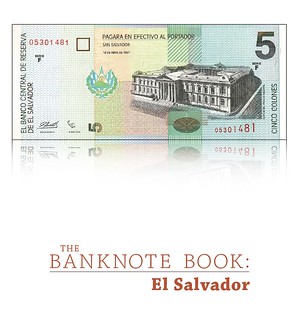 Previously published as a draft, we are proud to announce the publication of this 100-page catalog covering 808 varieties of notes issued in El Salvador from 1877 to 1999. This included the early Private Bank issues, along with the early Republic notes and all notes issued by the Banco Central de Reserva. For the first time ever, all of these notes are cataloged together and illustrated in full color with accurate descriptions. Additionally, all notes are priced up to the current market using the latest sales and auction data, revealing the true scarcity of many El Salvador notes.
Previously published as a draft, we are proud to announce the publication of this 100-page catalog covering 808 varieties of notes issued in El Salvador from 1877 to 1999. This included the early Private Bank issues, along with the early Republic notes and all notes issued by the Banco Central de Reserva. For the first time ever, all of these notes are cataloged together and illustrated in full color with accurate descriptions. Additionally, all notes are priced up to the current market using the latest sales and auction data, revealing the true scarcity of many El Salvador notes.
Comprising 316 individual country chapters (and growing!), with over 9,000 pages covering more than 80,000 types and varieties, the Banknote Book is the most comprehensive catalog of world paper money in existence.
Available as a digital subscription only, with PDF and pricing access via the greysheet.com web site and smartphone app.
Subscribe to The Banknote Book today. Subscriptions start at just $10/month, or $99/year.
The Banknote Book is also available as part of the Greysheet Subscription packages.
To subscribe to The Banknote Book, see:
https://www.greysheet.com/publications/the-banknote-book-world-paper-money
To read the complete article, see:
El Salvador Chapter of The Banknote Book Features Fully Revised Collector Prices
(https://www.greysheet.com/news/story?title=el-salvador-chapter-of-the-banknote-book-features-fully-revised-collector-prices)
NEW BOOK: BILLIONENSCHEINE
Here's a Google-translated article by Hans Ludwig Grabowski about a new book on Germany's inflation banknotes, from Geldscheine Online. -Editor
 Dießner, Hans-Jürg Alfred:
Dießner, Hans-Jürg Alfred:
Trillion Bills
The expenditures of the German Reichsbank and the emergency expenditures of the high inflation 1923/1924
378 pages, format 14.8 cm x 21 cm,
Paperback, Goldbach 2022
ISBN: 978-3-949958-01-4
Price: 35.90 euros
After Kai Lindman had already dealt with the subject in a catalog in 2003, Alfred Dießner, who is known to collectors as the author of the catalog on German emergency money from 1914/1915 , has now published his own revision .
With over 800 different issues of billions of bills of hyperinflation, the full-color catalog lists significantly more bills than Lindman, sorted by place of issue from A to Z. In addition, there are the trillion notes of the Deutsche Reichsbank and in the appendix special features, curiosities, manipulations, forgeries and more.
All certificates are listed with variants and are currently evaluated.
The foreword and the introduction to the Reichsbanknotes and the appendix were written in German and English.
In view of the fact that there is no revision of the emergency money of the high inflation for the entire German Reich and here still Dr. Arnold Keller is quoted with his catalog from 1958, the new catalog by Alfred Dießner is an important and up-to-date work, at least for the highest denominations of inflation.
Interested parties please send an e-mail directly to: info@rbnumisbooks.com.
To read the complete article, see:
Neuer Katalog: Billionenscheine
(https://www.geldscheine-online.com/post/neuer-katalog-billionenscheine)
NEW BOOK: LA COTE DES BILLETS DE LA R.C.F.T.O.
An article in Bulletin Numismatique No. 225, December 2022 announces a new catalog of notes issued by the Railway Administration of the Occupied Territories (Rhineland). Found via Notes & Notes from the Society of Paper Money Collectors (Volume VIII, Number 24, November 29, 2022). -Editor
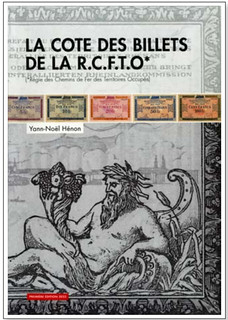 We will never repeat it enough, even if the Internet
provides a mass of useful information, the book of
reference is essential for a collection theme to live and evolve.
It is still necessary that the work be well written, well structured,
practical and brings new data.
Until today, the broadcasts of the R.C.F.T.O. had
not the chance to benefit from a complete analysis. It is now done.
We will never repeat it enough, even if the Internet
provides a mass of useful information, the book of
reference is essential for a collection theme to live and evolve.
It is still necessary that the work be well written, well structured,
practical and brings new data.
Until today, the broadcasts of the R.C.F.T.O. had
not the chance to benefit from a complete analysis. It is now done.
It was Yann Noël Hénon who embarked on this study. After his two publications Un Collectionneur… Un billet (generalist) and Les Billets d'urgence of 1940 (the reference on the subject), he therefore tackled this small series of ten banknotes issued there exactly a century ago.
In 1923, the German mark collapsed, banknotes were constantly replaced and their value no longer made sense. The head of the Régie des Chemins de Fer - based in the Rhineland after the first war - decides to issue a series of banknotes in francs in order to be able to continue the exchanges without using the mark.
Ten values, from 5 centimes to 100 francs, specimens, fakes, series, all the elements are present so that a collection theme is born. Yann Noël Hénon has done a lot of work listing the specimens found and the known archive data. These researches lead today to a booklet of 60 pages very complete and perfectly presented which references and Finally rating this show. Published on the author's account, with a sale price at 15 euros, there is no doubt that the 300 copies available will quickly find their place in the libraries! Request your copy now directly from Mr. Henon: yann.henon@orange.fr
WEBSITE: CANADIAN NUMISMATIC RESOURCES
A new website has been launched to host digitized literature on Canadian numismatics - Canadian Numismatic Resources (cnr-rnc.ca). Funding comes from the J. Douglas Ferguson Historical Research Foundation. The site currently hosts about 200 documents. Here is a description taken from the site. Check it out - this could be a useful resource. -Editor
Welcome to the Canadian Numismatic Resources (CNR) website. Here you will find digitized articles, books, journals, reports, manuscripts, and other documents related to numismatics and monetary history. All materials are presented in the language in which they were written or published.
This site is created and funded by The J. Douglas Ferguson Historical Research Foundation. Its purpose is to be a digital repository for materials related to Canadian numismatics and Canadian monetary history. The website is in constant development and new materials are always being added. Recommendations for additions to the site or suggestions for improvements to the site are welcome.
Most materials on the CNR website are no longer copyright protected. Every reasonable effort has been made to obtain permission for public use where required.
The Foundation relies mainly on donations to manage this website, fund important numismatic projects, and provide research grants. More information about the Foundation can be found at The J. Douglas Ferguson Historical Research Foundation.
To keep this website free, and enable the addition of new content, a donation to the Foundation through PayPal is welcome.
To visit the website, see:
https://cnr-rnc.ca/
For more information on the J. Douglas Ferguson Historical Research Foundation, see:
https://www.jdfergusonfoundation.ca/
E-SYLUM SUBSCRIBER CONTEST REMINDER
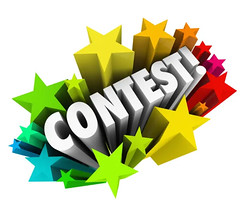 Longtime reader and E-Sylum booster Martin Kaplan has donated $100 as a top prize for a new subscriber contest. I'll give 2nd and 3rd prizes of $50 and $25. Here's how it'll work:
Longtime reader and E-Sylum booster Martin Kaplan has donated $100 as a top prize for a new subscriber contest. I'll give 2nd and 3rd prizes of $50 and $25. Here's how it'll work:
Send me ONE email at whomren@gmail.com with ALL the email addresses of people you think might like to become subscribers. List each address on a separate line. DEADLINE: DECEMBER 15, 2022. Put "E-SYLUM CONTEST" in the subject line and be sure to include your full name.
After the 15th I'll process the submissions in order of arrival, adding the new addresses and sending the newbies a note that it's a gift subscription on behalf of the entrant.
Only NEW subscribers count. If someone's address is already on our list they won't get added again. So no need to determine whether they already subscribe - there's no harm in having too many addresses.
Contest results will be announced in the DECEMBER 25, 2022 issue. Who will supply the most new subscribers?
Remember, only send me ONE contest submission. And don't spam internet randos - these should be people you know at least in passing, like fellow club members, customers, dealers you work with, or just fellow numismatists likely to enjoy The E-Sylum. If you like, include with your entry a message to be sent with your gift subscription.
To read the earlier E-Sylum article, see:
NEW E-SYLUM SUBSCRIBER CONTEST!
(https://www.coinbooks.org/v25/esylum_v25n47a02.html)
THE BOOK BAZARRE
ANDREW W. HARKNESS (1934-2022)
Bryce Brown passed along notice that Andrew W. Harkness passed away this past summer. He was the author of Agricultural and Mechanical Society Medals of the United States. -Editor
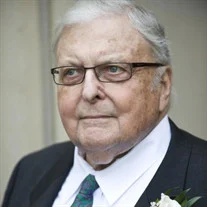 On Sunday, July 3, 2022, Andrew W. Harkness passed away peacefully at the age of 88. He was born June 3, 1934 in Glens Falls, NY to Andrew A. and Eleanor Harkness. He was a graduate of Earlham College and a proud veteran of the U.S. Army. He moved to Rochester in 1969 where he met his beloved wife of 43 years. Andrew was a retired auditor for the state of NY.
On Sunday, July 3, 2022, Andrew W. Harkness passed away peacefully at the age of 88. He was born June 3, 1934 in Glens Falls, NY to Andrew A. and Eleanor Harkness. He was a graduate of Earlham College and a proud veteran of the U.S. Army. He moved to Rochester in 1969 where he met his beloved wife of 43 years. Andrew was a retired auditor for the state of NY.
A voracious reader, who amassed quite a library including the complete works of his favorite author, Ayn Rand. He also had a passion for reading and collecting items relating to U.S. agricultural societies. Above all, he loved traveling and spending time with his family and friends. Predeceased by his wife, Mary Ellen. He is survived by his sons, Andrew and Ted (Julie); and grandson, Evan. Services were private.
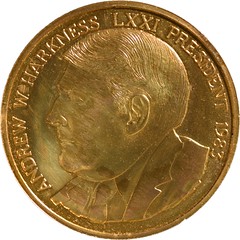
Pete Smith notes that Harkness was president of the Rochester Numismatic Association in 1983, and provided this image of his Presidential medal. Thanks. -Editor
Pete adds:
"Andrew W. Harkness joined the Token and Medal Society (TAMS) as member 951 in 1964. I was on the TAMS board in 2014 when he asked for a gold medal in recognition of fifty years of membership. TAMS did not have a fifty year member medal. I recall Kathy Freeland scrambled to provide one. I think we had something plated gold to give to him. I don't know if TAMS ever gave out another fifty year membership medal."
Kathy Freeland and Dave Schenkman confirmed that Andy received one of the first TAMS 50 year pins, and they were gold-plated. -Editor
RNA member Nick Graver writes:
"On my walk today I was thinking of Andy. His Agricultural medals were impressive."
Gerard Muhl noted that the September-October 2022 RNA News had this article. -Editor
Andy Harkness, our 71st president, has died this summer. He was an active member of the RNA for many years. He was best known for his expertise on agricultural medals, and he was the author of Agricultural and Mechanical Society Award Medals of the United States. Tim Corio provided photographs and Andy's son Ted helped with the third edition. In a 2014 article in the Democrat and Chronicle Jim Memmott stated that Andy was a rescuer of old medals and that he possessed the world's largest collection of agricultural and mechanical society medals.
Below Andy's very interesting preface to his book.
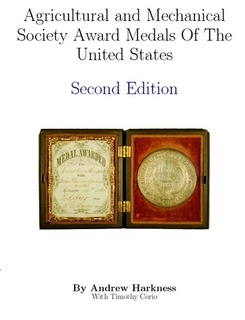 As I approach my 50th year on this project, it has become more and more possible to visualize these pioneers as they settled westward, coast to coast in just 100 years!
The medal recipients, and their fellows built the superstructure of this great nation which we
still build upon.
As I approach my 50th year on this project, it has become more and more possible to visualize these pioneers as they settled westward, coast to coast in just 100 years!
The medal recipients, and their fellows built the superstructure of this great nation which we
still build upon.
They, to be perfectly candid, did it all in a hundred years without a single indoor flush toilet
.
In 1969, building a civil war token collection gave me many pleasant hours in the collecting hobby. But, then I discovered a new area of collecting that would fill all of my hobby hours for the next forty years.
Lenard Babin, the great Rochester, New York coin dealer, introduced me to the world of agricultural and mechanical society award medals. He sold me a medal awarded by the Wisconsin State Agricultural Society at their frontier fair in 1870. It had been created for them as an award vehicle. It featured a seated goddess of agriculture (Ceres) on the obverse an area to be used to place the award inscription on the reverse. (This very medal illustrates the type in this book as Wi-10). It had been awarded to a dentist for the Best Exhibition of Practical Dentistry.
I was transfixed. Before me was a unique piece of frontier history that had been abandoned! When I realized the historical importance of what I had stumbled upon, civil war tokens became a thing of the past for me. I returned to Babin to purchase more medals. He had none to offer.
Leonard told me that building a collection of these medals would be very difficult because they were meant to be cherished and held forever. Some occasionally surfaced, however, when the passage of time diluted their importance to families. But, in Babin's long career only a handful of pieces had passed through his shop.
I began my quest by going to every coin show, antique show, and flea market. I read every coin publication advertisement and advertised in them myself., wrote letters to coin dealers all around the country and subscribed to most of the auction houses.
Over about two months, I acquired my second medal (American Institute), and after six months, medals began to come my way.
What I offer on the following pages are the images of each of the different medal types that I have found in 40 years.
Nick adds:
"The medal shown on the cover of his book is a presentation piece set in a thermoplastic case usually used to house Daguerreotype and Ambrotype photographs.in the 1850s. That was one of the earliest uses of plastics."
Thanks, everyone. Praise be for collectors like Andy with their singular focus to collect, study and document an area of the hobby for the ultimate benefit of all. -Editor
To read the complete online obituary, see:
Andrew W. Harkness
(https://www.beanandsonsfuneralhome.com/obituaries/Andrew-Harkness/#!/Obituary)
To read the complete RNA News issue, see:
RNA News : September-October 2022
(http://rochesternumismaticassociation.org/archives.php?news)
To read earlier E-Sylum articles, see:
NEW BOOK: AGRICULTURAL AND MECHANICAL SOCIETY MEDALS OF THE U.S.
(https://www.coinbooks.org/esylum_v12n51a05.html)
BOOK REVIEW: AGRICULTURAL AND MECHANICAL SOCIETY MEDALS OF THE U.S.
(https://www.coinbooks.org/esylum_v13n01a07.html)
NEW EDITION: AGRICULTURAL AND MECHANICAL SOCIETY MEDALS OF THE U.S.
(https://www.coinbooks.org/esylum_v13n48a07.html)
BOOK REVIEW: AGRICULTURAL AND MECHANICAL SOCIETY MEDALS OF THE U.S.
(https://www.coinbooks.org/esylum_v13n51a07.html)
AUTHOR'S RESPONSE TO REVIEW OF AGRICULTURAL AND MECHANICAL SOCIETY AWARD MEDALS BOOK
(https://www.coinbooks.org/esylum_v14n17a08.html)
ROBERT W. RIGHTMIRE (1940-2022)
Longtime
Robert Rightmire, 80, passed away on Nov. 21, 2021.
He is survived by his loving wife and best friend, Victoria Andritz; children, Deni Kea and Ryan Rightmire; grandchildren, Alex Kea, Kristina Kea and Alison Kea, and Vickie's sons, Kevin Andritz and Garrett Andritz.
Bob will be fondly remembered by his family and friends for his wide variety of interests, including theatre, arts, Oneonta College sports, American History, and collectibles of all kinds; he was truly a modern Renaissance man.
Bob was an E-Sylum regular as early as 2006. Here's what he wrote as we approached our 1,000th subscriber in November, 2006. -Editor
Bob Rightmire writes:
"I tend not to get caught up with a single number; numbers 999 or even 299 are important too. After publishing subscriber 1000's name, the spotlight should then turn to the very "publication" that we are reading. Might this be a time to honor all those, with you leading the way, who have made this wonderful source of information available? I indeed feel fortunate to be part of this circle."

He was a bibliophile, asking about book repairs in 2009: -Editor
"Recently two works, Loubat's The Medallic History of the US, 1776-1876 (1878) [oh, the wonderful plates!] and Baker's Medallic Portraits of Washington (1885) came my way. While the bindings were in deplorable condition, internally they were sound. In fact, the Baker had 12 uncut sheets.
"The decision to rebind (with 3/4 leather & marbled paper) was made so that the works could be consulted without additional damage to the contents; yet, the loss of the original bindings means that the books no longer exist as totally original documents. The intent of the authors/publishers now exist only as photographs. Is rebinding/restoration a detriment or an asset to maintaining the record of our numismatic literary heritage? "
One of Bob's research specialties was the Guttag Brothers of New York and their tokens and medals. In 2006 he asked for information and I and a number of readers responded to his call. -Editor
Bob Rightmire writes:
"Since you first posted my inquiry on the Guttag Bros., I had some excellent help and advice from several numismatists. Dick Johnson has lead the way with both information and some solid leads. Your copies of Guttag's Coin Bulletin yielded several facts about their business.
"I have learned that there is a picture postcard of the Guttag building at 42 Stone St., New York City (ca. 1930). Has anyone seen this postcard?
"The suggestion that I check the NY Times for references to the Guttag Bros. has been expedited by the Times' Select program which allows subscribers to download up to 100 entries, from 1851 to the present, per month.
"I'm currently looking for leads to Louis Guttag's children Alvin, Evelyn and Erma Frank (as of Mar. 29, 1972)."
Bob's wife Vickie Andritz writes:
"Bob was not just a collector. He enjoyed researching the topic to become more knowledgeable. He was always willing to share his findings with anyone who asked.
"I remember had a gold piece that he offered up in an auction. (I think in the late 80's early 90's.) We left school and headed into NYC to attend the auction in the Twin Towers. Some items were sold very quickly. When Bob's item came up, the bidding was constant, but with small increments. Bob was a little worried. Soon the bidding got very active and the coin sold for a little more than he anticipated. He bought a new car."
To read the complete online obituary, see:
Robert W. Rightmire
(https://www.lhpfuneralhome.com/obituary/robert-rightmire)
To read earlier E-Sylum articles, see:
MORE ON GUTTAG RESEARCH
(https://www.coinbooks.org/esylum_v09n41a13.html)
https://www.coinbooks.org/esylum_v09n48a02.html
(https://www.coinbooks.org/esylum_v09n48a02.html)
QUERY: ORIGINAL STATE VS. REBINDING
(https://www.coinbooks.org/esylum_v12n31a24.html)
QUERY: INFORMATION ON AUTHOR STARR GILMORE SOUGHTs
(https://www.coinbooks.org/esylum_v16n01a22.html)
NNP ADDS NOVEMBER 2022 SYMPOSIUM VIDEOS
The latest addition to the Newman Numismatic Portal are videos from the November 2022 NNP Symposium. Project Coordinator Len Augsburger provided the following report. -Editor
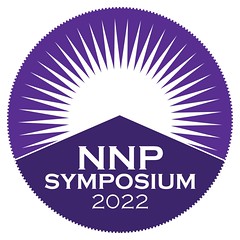 Video from the recent Newman Portal Symposium, held November 17-19, 2022 is now available. The Newman Portal Symposium brings together speakers on a wide variety of numismatic topics, including U.S., world, and ancient numismatics. Our feature presentation examined U.S. coins in the collection of the American Numismatic Society (ANS), which included comments from the ANS Resolute Americana chair of American numismatics, Jesse Kraft. Another well-attended session featured John Albanese speaking on the new CAC Grading certification service. Our next Symposium will be held this spring, in conjunction with the Central States Numismatic Society convention.
Video from the recent Newman Portal Symposium, held November 17-19, 2022 is now available. The Newman Portal Symposium brings together speakers on a wide variety of numismatic topics, including U.S., world, and ancient numismatics. Our feature presentation examined U.S. coins in the collection of the American Numismatic Society (ANS), which included comments from the ANS Resolute Americana chair of American numismatics, Jesse Kraft. Another well-attended session featured John Albanese speaking on the new CAC Grading certification service. Our next Symposium will be held this spring, in conjunction with the Central States Numismatic Society convention.
Link to Newman Portal Symposium home page on NNP:
https://nnp.wustl.edu/library/multimediadetail/539070
Link to American Numismatic Society feature video:
https://nnp.wustl.edu/library/book/620264
Link to CAC Grading presentation
https://nnp.wustl.edu/library/book/620268
VIDEO: DAN BROWN
The David Lisot Video Library on the Newman Numismatic Portal can be found at:
https://nnp.wustl.edu/library/multimediadetail/522852
We highlight one of his videos each week in The E-Sylum. Here's one from 1986 with Denver rare coin dealer and Assay Commissioner Dan Brown. -Editor
ANA Numismatic Personality: Dan Brown David Lisot, Interviewer.
He started collecting in 1927, joined the ANA in 1942, and was the #2 charter member of the Professional Numismatists Guild (PNG). Great numismatic history. Very interesting to note that he purposely did not hold an office with the American Numismatic Association, believing that it was a collector's organization that should be run by collectors, not dealers. -Editor
To watch the complete video, see:
https://nnp.wustl.edu/library/book/557347
EARLY WORLD PAPER MONEY PUBLICATIONS SOUGHT
Dennis Hengeveld writes:
"I was wondering if any of your readers may be familiar with a periodical called the Foreign paper money journal
that was published by Dwight Musser in Dunbar, WV from 1957 to 1959, and then continued as World paper money journal
in 1959-60 and finally World Paper Money Club bulletin
in 1960-1961. I have found very little other information regarding this publication. The three iterations are mentioned in Clain-Stefanelli but not much information can be found in that volume, except that it was continued by Paper money
, which may be the SPMC journal.
Internet searches have not turned up much at all. I would be interested in acquiring these to gain insight into the very early studies of world paper money, or at least learn more about them."
Great question - can anyone help? I don't believe the Newman Numismatic Portal has any of these. One thing NNP does have is the July/August 1993 issue of Paper Money which has on p135 an article about the early days of the Society of Paper Money Collectors by Charter Member Peter G. Robin. Here's an excerpt. -Editor
As did so many of us in our mis-spent youth, I started to collect U.S. coins while in high school, graduating to proof sets in my junior year (1955 or thereabouts). The Pittsburgh of that era had few coin shops that I could visit, and, in any event, prices for proof coins prior to 1952 were generally beyond the means of a teenager.
One day, I saw an ad of Lauren Benson of Davenport, Iowa offering 100 pieces of German Notgeld at $1.50. 1 ordered them, and became hooked for life. I quickly bought out his limited supply of other foreign notes, and he was good enough to put me in touch with Dwight Musser in West Virginia. Dwight, whom I did not get to meet in person until seven or eight years ago, can be credited, in my humble opinion, as the founder of organized foreign paper money collecting. His price lists evolved into News Letters which provided virtually the only information available in English about foreign bank notes. I still remember with pride being listed in his "Climbers Club" as the happy possessor of notes from sixty-nine different countries.
Somewhere along the line, the News Letters became the voice of the World Paper Money Club, and I took on the delightful tasks of General Secretary. Those were glory days indeed when known collectors numbered in the dozens and rarities could be had out of dealers' junk boxes with just a little effort and luck.
The year 1959 saw the formation of the Maryland Foreign Paper Money Club under the leadership of John Sandrock. I joined a year later, if memory serves, and became editor of its journal. The Currency Collector, in the early part of 1964. I was freshly out of the Army and just as freshly married. The MFPMC survives today, in a truncated and re-named version— World Paper Currency Collectors— mostly through the one-man efforts of Paul Curtis in California.
The end of 1961 saw the first issue of PAPER MONEY, the journal of the Society of Paper Money Collectors. The president and editor was Hank Bieciuk. On the back of the contents page, listed very legitimately as well as alphabetically last, was my name as a member of the Board of Governors. This fluke of fate, which put me in the same group as Amon Carter, Jr., Julian Blanchard, William A. Philpott, Eric P. Newman and others of their stature, was due to an administrative decision on the part of SPMC to accept the World Paper Money Club as a junior partner in a merged membership; the WPMC officers were to hold (very temporarily, it turned out) seats on the new board.
As far as I am aware, there was little interest shown by either U.S. or foreign paper money enthusiasts for making PAPER MONEY a truly internationally-oriented publication. The first year and a half saw the publication of two brief articles by Dwight Musser; the next non-U. S. item was published in the Spring, 1964 issue. It is fortunate indeed, for those of us interested in foreign bank notes, that the International Bank Note Society came into being at roughly the same time. Both periodicals have grown slowly but very surely into extremely fine purveyors of information and enthusiasm, without which few of us would likely continue to collect.
Can anyone put us in touch with current or former members of the Maryland Foreign Paper Money Club or the World Paper Currency Collectors group? Does anyone have a file of Dwight Musser price lists, News Letters or other world paper money publications? -Editor
NOTES FROM E-SYLUM READERS: DECEMBER 4, 2022
Young America Furnace Company Note Misspelling
Last week I asked, "what word on the note is misspelled? " -Editor
"I make occasional mistakes, but I spell it as young."
Correct. On some of the notes the word "Young" is spelled "Yonng". I attribute this to an error in typesetting, made more likely because the letters "u" and "n" are identical upside-down. -Editor
To read the earlier E-Sylum article, see:
NOTES FROM E-SYLUM READERS: NOVEMBER 27, 2022 : Young America Furnace Company Note Signer
(https://www.coinbooks.org/v25/esylum_v25n48a12.html)
More on the Sponsian Coin
"I found the discussion about the mystery Sponsian coin interesting. I was surprised that other numismatists were not mentioned in the news items, although the Hunterian is highly regarded. The reverse looks very odd and seems to be overstruck or badly cut.
Quite true.
Fake
does not necessarily mean new. It could be an ancient fake or even a ruler who was trying to regain power after an alleged coup!"
That article really went viral, travelling everywhere before other numismatists had much chance to chime in. Thanks to our readers who expressed their opinions and doubts. -Editor
To read the earlier E-Sylum article, see:
COIN OF SPONSIAN IS GENUINE. OR IS IT?
(https://www.coinbooks.org/v25/esylum_v25n48a22.html)
Economist Article on the Sponsian Coin
Patrick Parkinson writes:
The Economist has a long article on the analysis of a hoard found in 1713 in Romania.
Thanks - this is the same topic - the coins of Sponsian. -Editor
To read the complete article (subscription required), see:
A name may be missing from the annals of imperial Rome
(https://www.economist.com/science-and-technology/2022/11/23/a-name-may-be-missing-from-the-annals-of-imperial-rome)
On the NGCx 10 Point Grading Scale
Steve Shupe of Los Gatos CA writes:
 "I find the 10 point grading to be a misnomer, since in reality there are 100 points to the grading scale as implemented. You have 10, 9.9, 9.8, 9.7 etc.
"I find the 10 point grading to be a misnomer, since in reality there are 100 points to the grading scale as implemented. You have 10, 9.9, 9.8, 9.7 etc.
"I have been hearing for many years about changing the grading scale to 100 points, so numismatics matches other collectibles like sports cards.
"As a collector, It really doesn't really matter to me which scale is used, but I can already see this as a heyday for dealers and grading companies hyping the new scale, collectors changing holders to the new scale and so on.
"I can imagine someday that the old (current) holders will be desired by the crack out artists. Buy at Its only a 70
and sell at a 100.
"It might bring in some new collectors since it is a more understandable scale for newbies.
"I think it was very smart for NGC to launch the new grading scale the way that they have. Will this be like the Regency PCGS holders? Time will tell."
Tom Bridgeman writes:
"In regards to NGC going to a 10 point grading scale.....just another scam they are trying to push for profit. The grading business as it stands is quite questionable and full of misattributed and miss-graded coins...now they want to stir things up and "potentially" hope everyone goes back to having graded coins Re-Graded, at a fee of course! As you may have noticed, but I have a very biased opinion of the 'Slabbing" system, but it is an honest and fair opinion of a new money grab idea."
To read the earlier E-Sylum article, see:
NGC INTRODUCES 10-POINT COIN GRADING SCALE
(https://www.coinbooks.org/v25/esylum_v25n48a19.html)
Samuel Brooks and the Manly Medal
Peter Jones writes:
"I read with interest the article on medal collecting and heartily endorse what it says!
"There is more real estate on medals, they are often more artistic, more historic, often in better condition, more diverse, and more rare.
"The paragraph that starts Medal Collecting in America however, may be incorrect.
"The description of the Manly medal as engraved by Joseph Wright prompts me to show these photos of the truncation of the original and second obverse truncations of Washington's shoulder.
"The first obverse medal (Musante GW-10) was engraved with S BROOKS F on the truncation (i.e., Samuel Brooks fecit). The second obverse medal (Musante GW-11) was engraved with SBF on the truncation.
"According to Musante's Medallic Washington, Baker's Medallic Portraits of Washington, and the Forrer Biographical Dictionary of Medallists, the engraver was Samuel F. Brooks, who Manly employed to engrave the dies. Brooks was a goldsmith and seal-engraver in Philadelphia around 1793 and engraved the Manly medal in 1790. He relocated to Norfolk, Virginia in 1795 as a successful silversmith and engraver.
"Joseph Wright did not engrave the medal. The medal was not taken from a Washington portrait in 1784. James Manly, an English artist entrepreneur, traveled to Boston to make an engraved copy of the Christian Gullager oil portrait of Washington (circa 1789) hanging there. Brooks used this as a base for his die engraving of Washington."
Thank you for setting the record straight. -Editor
To read the earlier E-Sylum article, see:
VOCABULARY TERM: MEDAL COLLECTING
(https://www.coinbooks.org/v25/esylum_v25n48a15.html)
A DUVIVIER PUZZLER
Chester Sullivan submitted this numismatic puzzle for E-Sylum readers. Thanks. -Editor
A PUZZLER IN THREE PARTS
This magnificent Comitia Americana medal, Washington Before Boston, was designed and engraved by Pierre Simon Benjamin Duvivier from anatomical details obtained by the French sculptor Jean-Antoine Houdon. When Duvivier crafted the Washington Before Boston medal he was serving Louis XVI as Graveur des médailles de Sa Majesté. But on July 9, 1791 (owing to Revolutionary turmoil) he lost that title and its monetary compensation.
His reputation as a medalist enabled him to continue working. For years he produced jetons and medals like the sensitive portrait of Jean Duvivier (his father) who'd preceded him as Graveur des médailles de Sa Majesté.
He made this preparatory drawing sometime in the month of July of 1796. The work was done on private commission and it's indeed unique. It poses three questions to puzzle-minded numismatists:
- Who is the woman depicted in the drawing?
- How is she related to American numismatics?
- What is the astonishing anomaly in the drawing?
ANA OPENS 2023 AWARD NOMINATIONS
It's that time of year - the ANA is accepting nominations of deserving individuals for their various service awards and the Numismatic Hall of Fame. Here's the announcement. Who would be deserving winners? Who would you like to nominate? It's not hard, but does require some paperwork. Start gathering information about your candidate(s). -Editor
Deadline for Award Nominations is January 15
Each year, the American Numismatic Association (ANA) presents awards to deserving individuals in recognition of outstanding dedication to numismatics. The ANA is now accepting individual nominations for 2023 awards and Numismatic Hall of Fame "Modern Era" candidates.
All nominations can be submitted in writing and online – 300 words or more for the Numismatic Hall of Fame, and 50-100 words for all other awards. Include the date of submission, the nominee's name, background information and birth date (if known). Nominations are accepted through January 15, 2023.
- Hall of Fame – "Modern Era" nominees (individuals living or deceased within 25 years prior to induction) will be considered. Candidates are not required to be present or past ANA members.
- Chester L. Krause Memorial Distinguished Service Award – The ANA's highest honor, this award recognizes years of outstanding, dedicated service to numismatics.
- Lifetime Achievement Award – Presented to an individual, family, firm or judicial entity for contributions to organized numismatics.
- Elvira Clain-Stefanelli Memorial Award for Achievement in Numismatics – This award honors women who have made a lasting impact to numismatic community and demonstrated lifelong commitment to the betterment of numismatics, whether through research, leadership or mentorship.
- Numismatist of the Year – Recognizes individuals within the numismatic community who have demonstrated long-term leadership in the field and to the ANA. Nominees need not be ANA members.
- Harry J. Forman Dealer of the Year Award – Honors professional numismatists who exhibit uncommon dedication to strengthening the hobby and the ANA and displays exemplary ethical standards as a numismatic dealer.
- Numismatic Art Award for Excellence in Medallic Sculpture – The award honors an artist whose cumulative lifetime achievements in the field of medallic sculpture have been of the highest order.
- Adna G. Wilde Jr. Memorial Award for Exemplary Service – Recognizes collectors and hobbyists who are active at the regional and/or national level and work to advance numismatic knowledge among the general public.
- Medal of Merit – Recognizes individuals who have dedicated numerous years of service to the ANA and promotion of the hobby.
- Glenn Smedley Memorial Award – Recognizes collectors and hobbyists active at the grassroots level.
- Lawrence J. Gentile, Sr. Memorial Award for Outstanding Adult Advisor –Recognizes individuals who have devoted their time and efforts to recruiting young numismatists new to the hobby, and aiding the development of intermediate to advanced YNs.
- Young Numismatist of the Year – Honors numismatists under the age of 18 for outstanding contributions to the hobby and who are active in volunteer service and numismatic research.
- Outstanding District Representative – Recognizes the District Representative who most fully promotes coin collecting, coin clubs and the ANA.
Submit a nomination for a numismatist you find deserving of an award. Information about each of the awards and online submission forms can be found at https://www.money.org/service-awards-categories .
For questions about the awards, please contact awards@money.org or call (719) 482-9811.
ANA SEEKS NEW EDUCATION DIRECTOR
The ANA is also seeking a new Education Director - this could be a perfect match for an E-Sylum reader! -Editor
The American Numismatic Association (ANA) is prioritizing successful online learning experience in its search for a new education director.
The new director will be responsible for implementing a sustainable online education program while continuing and improving upon existing programs. According to ANA Executive Director Kim Kiick, the individual should possess Learning Management System (LMS) project management experience along with lesson preparation and instruction.
The successful candidate will take the reins from recently retired Education Director Rodney Gillis, who served the ANA for nearly 17 years. Rod contributed to our educational mission in a myriad of ways,
says Kiick. He was an excellent instructor, wrote numerous articles, recorded educational videos, revised the ANA Diploma Program, and so much more, but he was especially passionate about instilling excitement for the hobby in young people.
The newly expanded education director role will be responsible for overseeing educational content development and programs for a new eLearning platform, and collaborating with national numismatic volunteers for teaching in the Association's eLearning Academy, technical seminars and acclaimed Summer Seminar. A major focus will be implementing a new Learning Management System. The ANA is also planning to hire a LMS Program Manager in the near future, who will report to the new education director.
This newly expanded education director role is critical to the mission of the ANA,
says Kiick. If we want to attract future generations to the hobby, we need to present information and resources to them in a format that they want and are readily familiar with.
Individuals interested in the position should visit info.money.org/education-director-position.
VOCABULARY TERM: MEDAL MANUFACTURING
Here's a great entry from Dick Johnson's Encyclopedia of Coin and Medal Terminology on the history of medal manufacturing. See the complete entry online for a list of various medal types. -Editor
Medal Manufacturing. The production of medallic items, usually diestruck on presses (larger items are cast or electroformed), often smaller medals are made at mints as an ancillary activity to coin production. Medal making as an industry, with separate companies specializing only in making medals and similar products, did not exist until the early 19th century in Europe and not until 1892 in America.
Medal manufacturing includes more than three-quarters of the techniques detailed in this encyclopedia, from design through every step of production and with the finishing and mounting of custom-made medallic items. This indicates that coining uses much of the same technology as employed by medalmakers (which has some of its own distinctive technology, of course) but often when new striking technology is introduced it is tried first on medals before it is adapted to coins.
Medal making in Europe. Medal making passed through three stages before a medal industry was created in Europe. The first stage was artists casting medals in their own workshops or studios (atliers). Pisanello and his followers first cast medals beginning in 1438 and this practice continued during the Renaissance. For another century medal artists worked only in their own work-shops. goldsmiths, then, were the manufactures of medallic items with a blending of objects where it is difficult to tell where medals differ from jewelry (or jewelry, pendants and such, perhaps, differ from medals). Benvenuto Cellini and Hans Reinhart the elder were noted examples of goldsmith medallists.
The goldsmiths of Nurnenberg and Ausgsburg had access to coin and medal equipment – rolling machines, screw presses for blanking and striking – to produce the first struck medals and this was the second stage of medal making. These were smaller than the cast medals of the Renaissance and early goldsmiths. These medals were nearer to coins in size and style because of the similarity of manufacture and use of coining equipment. These goldsmiths were often the court jewelers who also manufactured decorations of honor, the collars, stars, badges of orders and chivalrous societies.
With the industrial revolution and the development of striking presses, beginning with Matthew Boulton's Soho Mint (1789), and later the Dietrich Uhlhorn's press (1812), medal making moved to coinage mints, the third stage of European medal making. Dies were cut much like coins. Mints had two kinds of presses – coining for up to dollar size coins –and screw presses normally used for hubbing. If the medals could not be struck on coining presses, they could be pressed, laboriously, and at a much slower pace, one at a time, on screw presses.
The Wyon family of engravers came to England, settled in Birmingham, did some die engraving for Matthew Boulton, a branch of the family also located in London. Here William Wyon was to dominate medal manufacturing, but he, his son, and many other Wyon family members were engravers at the Royal Mint. Their medal issuing was interspersed with coin engraving.
It was not until mid 1800s (the firm uses the date 1836) that Stefano Johnson was established in Milan, devoted solely to medallic productions. This marks the beginning of the private medal making in Europe. Since that time Artrus Bertrand was established in Paris; Ortel, Mayer and Laurer in Germany; Schneider in Austria, Fonson in Belgium, Pinches in England, Heguein in Switzerland, and a number of medallic companies in Sweden, Spain, Portugal and elsewhere.
Medal making in early America. When a thankful Continental Congress wanted to issue a medal to George Washington (for his successful campaigns in the Revolutionary War) Benjamin Franklin had to go to France, and to the Mint there in Paris, to have these struck. The Washington Evacuation of Boston Medal, 1789 (also known as Washington Before Boston Medal) was the first of ten such Congressional authorized medals, for military and naval heroes. These medals were all designed and engraved by French medallists and struck at the Paris Mint (Julian MI-1, MI-2, MI-3, MI-5, MI-6, MI-7, MI-8, MI-9, MI-10, NA-1, IP-50, CM-15).
With the establishment of the United States Mint in 1792 the first coins were struck, and, perhaps (since we do not know exactly when) the first metal. Rickett's Circus Medal was struck in either 1792 or 1793. It had a coat of arms on the obverse and the name (misspelled with two s's) on the reverse. This first medal was struck for a private organization, one that had nothing to do with national interest, but was allowed to be made at the mint.
For the next 156 years any American organization could have the United States Mint strike a medal for them! (As long as it was not political in nature, thus campaign medals had to have been struck by private medal makers.) For much of this time a medal industry just did not exist in America.
Early private medalmakers. If you wanted a medal, say an award medal, your choices were very limited. You could have the medal (of any size) hand engraved, as were the first Indian Peace medals, and many early American medals. For a struck medal you were limited to less than an inch in diameter (struck by small one-man shops, operated by the engraver with a single small press). For a large medal (say, over two inches) there was no manufacturer in America that had the equipment to produce such an item. Large medals either had to be struck at the U.S. Mint or struck overseas.
Thus early American engravers controlled medal issuing for the first half century of 1800s. Only a handful of these craftsmen existed in America, mostly in New York, Philadelphia and Boston. These few private makers of small size medals did their own engraving, diesinking, and striking on makeshift screw presses, and, rarely, did medal finishing.
Usually these craftsmen would do any form of engraving – carve cameos, engrave seals, monogram silverware, do flat engraving of prints, or the roller dies for printing long strips of paper (as wallpaper!). All this in addition to cutting dies, that is diesinking, for striking tokens and medals. Yet, not all these die engravers had presses to stamp these small items. Those who did had rather primitive equipment. If they had a press they called themselves a firm: Bale and Smith, Wright and Bale, Smith and Hartmann, or such.
A turning point in this history was a shortage of coins, particularly cents, just
prior to the Civil War. Thus these hand engravers made merchants tokens
in cent size to alleviate the cent shortage. Enterprising merchants bought tokens from engravers who would engrave dies with the name, address and some statement about the merchant's business on them. Merchants passed these off as one-cent coins. This served both to relieve the cent shortage and be somewhat of a promotional item for their businesses.
These diesinkers could make medals as well as tokens and some did. By leaving off any reference to a denomination or exchange for some product, these items were technically a medal (but circulated for cents because of the similarity in size and composition). But all had to be less than one-inch diameter because of the primitive striking presses, however.
In 1851 the New York jewelry firm, Tiffany & Co., made its first medal. They did the same as other organizations. Other than a few small medals (later struck in their silverware plant in Newark), and a few medals struck at the U.S. Mint, Tiffany contracted for most large medals produced in Europe. They were followed, on a smaller scale, by Gorham Company, in Providence, Rhode Island; Bailey, Banks and Biddle in Philadelphia; and later by Reed and Barton in Baltimore for a very few medals.
Modern medalmakers. It really wasn't until the Columbian Exposition in 1892 in which medal makers were attracted to come to America to produce an unprecedented quantity of medals. August Frank came from Germany to Philadelphia, where William W. Warner, Silas Quint and Joseph K. Davison's Sons were already established, making Philadelphia the center of medal making in America at the turn of the 20th century.
But other medal makers sprung up elsewhere: Whitehead & Hoag, in Newark (they purchased their first press in 1899 and established a medal department in a new building, 1904), for example. Earlier C.D. Childs had moved his firm from Boston to New York to Chicago, where another firm started up during the 1892 World's Fair: Greenduck. also Schwaab Stamp and Stencil was located in Milwaukee.
The medallic products of each of these firms were tied to the engraver employed by the firm (usually a proprietor), and the kind of equipment each had. A numismatist experienced in American medals can often look at a given medal and recognize the work of these firms they were so distinctive. In one instance where Childs received a commission for a large medal they could not strike with existing equipment they, again, had these produced in Europe.
With the importation from France of a machine to cut dies from oversize models, two Frenchmen, Henri and Felix Weil started, in 1907, what was to become Medallic Art Company in America. This firm, from very lowly beginnings was to grow to dominate medal production in this country in the 20th century.
Their concept was entirely different from all other medal companies operated by engraver-proprietors in the country. By using oversize models the Weil brothers turned to sculptors to prepare the patterns for medals, from which they made the dies (cutting them on the die-engraving pantograph – the Janvier pantograph from France). Medal making transferred from the hand engraver cutting dies exact size needed, to an artist who could work in any media – clay, wax, metal, wood, plaster – whatever the sculptor found convenient.
A metal shell, an electroformed GALVANO was made from this original model and served as the pattern to be mounted on the die-engraving machine. The galvano was a permanent metal pattern from which new dies could be produced at any time and in any size, to replace a broken die, or to easily revise the design or lettering (should that be required by the client). This process was beneficial for these stated reasons and eliminated the tedious engraving of dies by hand.
At first it was, in fact, sculptors who brought the medal jobs to Medallic Art Company; organizations would commission the sculptor, and Medallic Art served the sculptor to produce their medals. After 1929 Medallic Art, under an aggressive new owner, Clyde Curlee Trees, sought the jobs directly from organizations, then the firm commissioned sculptors to prepare the models.
Previously in the 19th century, every medal of the engraver/proprietor firms looked nearly alike (because it was the work of one or two engravers); Medallic Art medals each looked different! Their medallic work looked varied because it was by different artists. Each sculptor had his own style and technique, usually, from all other sculptors. The firm reproduced the work of over 300 sculptors in the first sixty years in business.
Medallic Art had a number of competitors: Whitehead & Hoag and Davison's Sons at first, Metal Arts, Bastian Brothers and Robbins later on. (Whitehead & Hoag went out of business in 1964, selling out to Metal Arts of Rochester.) August Frank Company, whose medallic work had diminished after the death of its founder in 1946, sold out to Medallic Art in November 1972. Some of these firms did reproduce the work of commissioned sculptors, most, however, employed factory artists to create their medallic models.
Thus anyone who wanted a medal struck went to diesinkers in the first half of the 19th century, then to jewelry firms after the Civil War, then, near the turn of the 20th century, to sculptors. After World War I trophy houses began to make medals, created for the most part to supply the growing need for sports award medals. Then to advertising specialty firms when businesses began employing medals for a wide range of promotional needs, commemoration and incentive awards.
Finally, in the 1960s began the rise of medallic firms established solely to create medallic items for sale to the public. Franklin Mint's success spawned imitators, mostly short-lived, but a new class of medal manufacturers arose just to produce collector medals, the private mint.
It wasn't until 1948 when the United States Mint stopped accepting orders from private organizations in direct competition with these private medal makers – who had, by then, acquired large presses and other equipment to strike medals of any size. But for existing orders (or where the Mint still had the dies) the U.S. Mint continued striking private medals. It was not until 1956 the U.S. Mint struck their last private medal.
Reasons for issuing a medal. The overwhelming reason to issue a medal was to commemorate an event. This could be any event from the inauguration of a president or man's walk on the moon to the winner of a foot race in a local athletic contest. Medals become a permanent record of this event. The attached Word List of Medal Types – words often found on the medal itself – give an indication of the many events which can and have been immortalized in medallic form.
A most interesting reason, a name change, for issuing a medal occurred in 1866. The New York Free Academy (an educational organization founded in 1847) changed its name to College of the City of New York. It issued a medal for the event, engraved by William H. Key. In later years, when organizations and institutions changed their name, they would have it changed on any current award medals causing new dies to be made (die retooling) with new varieties for collectors.
Rise of proof surface medal manufacturing. Proof surface coins were struck by the U.S. Mint in the 19th and early 20th century as an accommodation for collectors. It resumed striking these in 1936, only to cease during World War II. It resumed again in 1950 with increasing collector interest. It proved so popular that sales of these reached exorbitant heights, far surpassing the number of numismatists or even the number of serious collectors in America. The general public was buying these and forming an interest in coin collecting.
If coins made with a proof surface were so popular with the public why not custom designed medals in proof surface? Several of the newly formed private mints tried, but one, Franklin Mint, was outstandingly successful. They created 66 series of medals and hundreds of single issues before the market could absorb no more proof surface items.
Throughout this entire development, over half a millennium, the one constant has been the artist, the person who creates a design to be immortalized in metal. It has only been the men and machines which produce that medal design that have changed dramatically in that time: the medal manufactures.
To read the complete entry on the Newman Numismatic Portal, see:
Medal Manufacturing
(https://nnp.wustl.edu/library/dictionarydetail/516296)
THE BOOK BAZARRE
100 Greatestlibrary), Dr. Harvey B. Richer reveals the rarest, the most expensive, the most famous and most historic of Canada's coins, each with a fascinating story. 160 pages, coffee-table, hardcover. Order your copy online at Whitman.com , or call 1-800-546-2995.
HAPPY 100TH BIRTHDAY, KAY LENKER!
American Numismatic Biographies author Pete Smith submitted this article on the newest numismatic centenarian, Kay Lenker. Happy 100th birthday!! Thanks, Pete. -Editor
Each year the Numismatic Literary Guild presents awards during the American Numismatic
Association World's Fair of Money. With good food and entertainment, the NLG Bash
has
been popular with members and guests.
The highest annual award is The Clemy.
named in honor of NLG founding member Clement
Bailey. I attended the NLG Bash
on August 18, 2011, when the Clemy winner was announced.
I rose to my feet and walked to the stage as the crowd gave a round of applause.
The applause was not for me. Taking my arm for support was Kay Lenker. The applause was for her. She was 89 at the time and had been a supporter of the NLG for many years including service as club treasurer 1985 to 2012.
Catharine R. Fean was born in Philadelphia on November 29, 1922. Her father was a mail carrier, Albin J. Fean, and her mother was also named Catharine R. (1898-1989). She received a B.A. from Immaculata in 1944 and an M.A, from San Diego State University in 1976.
Kay was certified as a meteorologist in 1945 and served on active duty in the U. S. Navy from 1944 to 1954. She retired from the Navy Reserves with the rank of Captain. She then worked with the United States Weather Bureau from 1955 to 1958 and with the Scripps Institute of Oceanography 1958 to 1978. She continued working as a consulting meteorologist 1978 to 1981.
She developed an interest in collecting coins in 1955. With her husband posted to Japan 1962 to
1965, she developed an interest in Japanese coinage. In the 1970's, she was a frequent exhibitor
at shows in Southern California and often received best-of-show
awards. She joined the ANA
in 1961 and converted to life member LM 626. She was certified as an ANA judge in 1976. In
recent years I judged an exhibit she had on Wildman
coins.
As Catharine R. Fean, she was co-chairman for the San Diego Numismatic Society banquet committee in 1960 and an exhibitor in 1961. She was publicity chairman for the San Diego County Interclub Numismatic Council Coinarama in 1961.
Kay married Stuart T. Edgerton on September 1, 1961, and their marriage ended with his death on February 15, 1978. Her second marriage was to John E. Lenker on January 26, 1980, and lasted until his death on April 14, 1993.
It might take a century to compile a list of her service to coin clubs. She has organized exhibits, managed publicity and been a program speaker. Here is an attempt, probably incomplete, to list offices she has held.
- American Numismatic Association (ANA), board member 1995-2003, general chairman for the ANA convention in San Diego in 1983.
- California Exonumist Society, president 1991-92, show chairman 1991-92, secretary 2008.
-
California State Numismatic Association (CSNA), show general chairman 1972-1975, 2002-
2004, bourse chair 1989-99, treasurer in 1990-2013. In 2001 she became
Assistant Editor South of the Tehachapis
for Calcoin News and served until the publication merged in 2003. She then worked for The California Numismatist until 2006. - Convention of International Numismatics (C.O.I.N.), secretary.
- International Primitive Money Society, secretary/treasurer.
- Numismatic Association of Southern California (NASC), board 1988-89, recording secretary 1990-1995, treasurer 1996-2008.
- Numismatic Literary Guild, treasurer and co-treasurer 1985 to 2012.
- Redlands Coin Club, recording secretary 1981, secretary/treasurer 1993 to 1995.
- San Diego County Inter Club Numismatic Council, president 1972, 1981, editor 1973, secretary 1977, show general chairman 1972-74. treasurer 1986, bourse chair 1991-2011.
- San Diego Numismatic Society, secretary for twenty years 1982-1997, president for six years.
Kay was named a Krause Publications Numismatic Ambassador in 1987. She was honored for her service with an ANA Outstanding District Delegate Award in 1992 and a Glenn Smedley Memorial Award in 2003. As mentioned earlier, she received the NLG Clemy Award in 2011. In 2022 she was honored with the Elvira Clain Stefanelli Memorial Award for Achievement in Numismatics.
I wrote this article on November 29, 2022, on the occasion of her 100 th birthday. She now joins the elite group of 100-year-old numismatists. I will be interested to hear how she is doing.
Although I refer to her as Catharine, her name also appears as Catherine. I found these references to her on the Newman Numismatic Portal.
- Catharine Fean – 2
- Catherine Fean – 3
- Catharine Edgerton – 153
- Catherine Edgerton – 86
- Kay Edgerton – 1106
- Mrs. Stuart Edgerton - 3
- Catharine Lenker – 17
- Catherine Lenker – 7
- Kay Lenker – 1282
- Catharine Edgerton Lenker – 68
- Catherine Edgerton Lenker – 17
- Kay Edgerton Lenker – 977
- Mrs. John Lenker - 2
When she worked for Scripps, she wrote a report published under the name of Catharine Fean. In the 1930 Census, her name is recorded as Catharane Fean.
In the 1940 Census, her name is recorded as Catherine R. Fean.
I interviewed her at the ANA convention on August 13, 1991. I recorded her date of birth as November 29, 1922. I have not found another source to confirm that date. The Clustrmaps.com site lists her date of birth as June 1, 1923. The Newber.com site lists her as male.
The inconsistencies seen in this case are not unusual with similar research.
Ken Berger put me in touch with Peter Lenker and Ginny Bourke who reports that Kay is doing OK. She wrote that "we dedicated the 2022 San Diego Coinarama show to Kay and had a brief history of her in the program." Were any of our readers present at the event? How was it? -Editor
To read the earlier E-Sylum articles, see:
ALAN HERBERT 1926-2013
(https://www.coinbooks.org/esylum_v16n04a06.html)
100-YEAR-OLD NUMISMATISTS
(https://www.coinbooks.org/v24/esylum_v24n51a14.html)
THE CHESTER L. KRAUSE LEGACY PARK
Clifford Mishler is the Fundraising Chair for a worthy effort to honor Krause Publications founder Chet Krause with a park in downtown lola, WI. Here's a description of this great project with information on how to contribute. -Editor
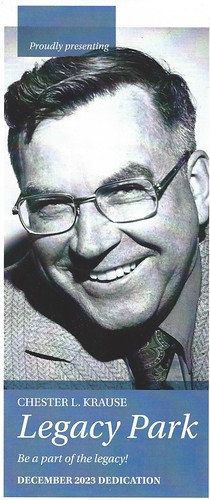 The open lot in downtown lola, at the intersection Water Street and Chester L. Krause
Drive, is presently undergoing development as the Chester L. Krause Legacy Park, honoring
"Chet's" life and contributions. The park development is scheduled for completion in the
Fall of 2023, in advance of the 100th anniversary of Chet's birth on December 16, 1923.
The open lot in downtown lola, at the intersection Water Street and Chester L. Krause
Drive, is presently undergoing development as the Chester L. Krause Legacy Park, honoring
"Chet's" life and contributions. The park development is scheduled for completion in the
Fall of 2023, in advance of the 100th anniversary of Chet's birth on December 16, 1923.
Chet's support of major projects and accomplishments in the lola community, and otherwise were substantial, long standing and unselfish. His personal style was to lead by example, reaching out for the betterment of his village neighbors, fellow hobby enthusiasts, family, humanitarians, or the man-on-the-street. Now, it's our turn as business associates, friends, neighbors and family to return that favor. This letter extends an invitation for you to consider making a monetary contribution in support of the Park development.
As a memorial to Chet's outstanding generosity and community leadership, our ad-hoc committee of his former business associates, neighbors and friends, whose lives were enriched by his philanthropic and selfless example, set out to pursue the park development to honor his memory in perpetuity. It will provide a reminder, to visitors and residents alike, of the role Chet played in the lola community and the hobby communities served by Krause Publications, commencing in 1952 with the publication of Numismatic News, and the 1973 establishment of the Iola Old Car Show. In 1960 he was also involved as a founding member of the Numismatists of Wisconsin.
 Chet always reminded those with whom he worked and crossed paths that; "Some people say
give until it hurts. I say give until it feels good." Now, it's our turn to complement his legacy.
Chet always reminded those with whom he worked and crossed paths that; "Some people say
give until it hurts. I say give until it feels good." Now, it's our turn to complement his legacy.
The budget for the Chester L. Krause Legacy Park is presently projected to be around $230,000. Of that total, the major costs involve the installation of a bronze/granite statue of Chet in the park's northeast corner, a life-size execution by nationally renowned sculptor Eugene Daub, with the backdrop of an expansive mural on the south end, created by local talent Jordyn Brennan, that will capture many of his lifetime accomplishments, intertwined with lola's heritage. The park will also feature a lighted flag plaza and a couple shelters.
Donations for this project are welcome in any amount. All contributions will be accepted by the Village of lola, acknowledged and entitled to treatment as tax-deductible donations in accordance with applicable state and federal income tax statutes.
All contributions should be directed to:
Chet Krause Park Fund
Village of lola
P. 0 Box 336
lola, WI 54945-0336
If additional information is desired, please contact:
Clifford Mishler
P. O. Box 316
lola, WI 54945-0316
715-445-5050
mish@EclecticPursuitslola.com
Your consideration and generosity will be appreciated ... as an expression of gratitude and tribute for the generous support evidenced by "Chet" Krause in his lifetime ... where lola and the greater area community area were concerned where his support on behalf of selected humanitarian organizations were concerned and where his avocational and professional connections to the coin collecting, old car enthusiast, and other hobby community universes with which he became involved as a publisher were concerned.
Consider heeding Chet's credo that held that it's good to give until it feels good!
NUMISMAGRAM MEDAL SELECTIONS: DECEMBER 4, 2022
Jeremy Bostwick at Numismagram forwarded these four standouts from his recent addition of new material to his website. For all of the new items, including an exceptional Admiral Vernon medal and a WWI-era British dog tag on a German East African rupie, please visit https://www.numismagram.com/inventory. -Editor
102217 | CUBA. Honradez Royal Tobacco Factory tin Medal. Issued circa 1859 (57mm, 88.15 g, 12h). PLAZA DE SANTA CLARA No 83 Y 85 TALLERES, CALLES DEL SOL No 17, DE SAN YGNACIO No 88 / Y CERRADA DE SANTA CLARA ENTRE SAN YGNACIO Y CUBA / DETALL, CALLE DE CUBA No 83 DE POSITO PRINCIPAL PARA MENUDEO CALLE DEL OBISPO No 15 / DEPOSITOS SECUNDARIOS, CALZADA REAL DEL MONTE No 154 / Y CALLE DE SAN RAFAEL ENTRE CONSULADO É INDUSTRIA / DIRECCION GENERAL / Y ESCRITORIO / CALLE DE SAN YGNACIO No 90 / HABANA, female personification of Justice standing facing, holding scales / REAL FABRICA LA HONRADEZ / AGRACIADA ESPECIALMENTE POR S. M. CON EL USO DE SUS REALES ARMAS / GRAN MANUFACTURA DE CIGARROS Y PICADURAS DE LUIS SUSINI É HIJO / PROVEEDORES DE LA REAL CASA &a. &a. / HABANA, complex Cuban coat-of-arms. Edge: Some scattered discoloring, otherwise plain. Gem Mint State. Wholly brilliant and lustrous, with a great cartwheel nature to the brilliance. Includes original paper casing with design of the medal on each side, though somewhat distressed. $365.
Cuban cigars have long been the standard bearer of a fine tobacco product, and Don Luis Susini's royal factory in Havana sought to keep that high standard through not just the firm's name (la honradez meaning "honesty" or "integrity"), but also through what was, at the time, revolutionary packaging. Counterfeiting was commonplace and copyright protection was virtually non-existent, so Susini turned to packaging in order to differentiate himself from fraudulent products, with the firm using color lithography to produce some of the world's first colored labels.
To read the complete item description, see:
102217 | CUBA. Honradez Royal Tobacco Factory tin Medal.
(https://www.numismagram.com/product-page/102217)
102203 | GREAT BRITAIN. England. Henry VIII silver faux-engraved Jeton or Gaming Counter. Issued circa 1635–1710, or slightly later. Series 5: Sovereigns of England: Half length (25mm, 1.83 g, 5h). By the school of Simon van der Passe. HENRY VIII KING OF ENGLAND FRANCE & IRELAND, mantled bust facing, wearing plumed cap and holding scepter / Crowned coat-of-arms within Collar of the Garter; all within elaborate border. Cf. Mitchener 4864-5 (obverse with a different style and legend). About Uncirculated. Lightly toned. A fairly rare type from a popular series. $495.
Gambling and games of chance have served as a form of entertainment and excitement during much of recorded history in one way or another, and many of these games necessitate some form of accounting during play. In early modern Europe, jetons were commonly employed for these purposes and allowed for skilled engravers to promote their artistry. One such engraver was Simon van der Passe, born in Utrecht circa 1585.
Van der Passe worked in England from 1616–1621/2, having founded a school after being exempted from the royal monopoly given previously to Nicholas Hilliard. This exemption allowed for the "graving and imprinting medailles" and small portraits of the king, and van der Passe utilized his technique for the production of numerous series of jetons or gaming counters, initially employing portraits of the Stuarts, James I and later Charles I with his wife, Henrietta Maria. Though Simon would return to Holland in 1621/2, his London-based school continued under the management of his brother, William. Subsequent issues of these jetons would feature Gustav Adolph and his wife, Maria Eleonora, the sovereigns of England, 'classical portraits' of historical and biblical figures, 'street cries,' and the Commonwealth.
Of even greater interest and debate among numismatists over the past century has been the method of manufacture of these jetons. Their appearance at first glance would lead one to believe that they have been individually engraved owing to their incuse design. It is thought that, in fact, these ornate counters were skillfully cast and polished in order to generate this 'faux-engraved' effect.
To read the complete item description, see:
102203 | GREAT BRITAIN. England. Henry VIII silver faux-engraved Jeton.
(https://www.numismagram.com/product-page/102203)
102245 | INDIA. Bengal Photographic Society silver Award Medal. Engraved and awarded to Sir William de Wiveleslie Abney in 1873 (51mm, 64.38 g, 12h). By J. S. & A. B. Wyon. Seminude female seated right, holding flower and plaque adorned with geometric design; lily pads in foreground below, palace arches behind / BENGAL PHOTOGRAPHIC SOCIETY, garlanded laurel wreath with inscription in four lines in varying scripts: "FOR HELIOTYPES / To / Lieutt. W. de W. Abney." Edge: Plain. Puddester 869.5. Choice About Uncirculated. Deeply toned and with a good deal of brilliance radiating from beneath; just a few light edge bruises are noted for completeness. Includes box of issue. A rare early award from this society, awarded less than two decades after the society's founding. $645.
An English astronomer, chemist, and photographer, William de Wiveleslie Abney was born in 1843 and educated at the Royal Military Academy. He would go on to serve with the Royal Engineers in India, where he would continue his interest in the still-recent technology behind photography. His background in chemistry and astronomy allowed him to combine all of these skills, such as with his development of a "dry" photographic emulsion (as opposed to the normal "wet"). It was with this dry emulsion that he photographed the transit of Venus across the sun during an expedition in Egypt. This prize medal, one of the earliest awarded of the type, was issued during Abney's time in India, and honored his work on heliotypes–a process involving the transferal of images from photographic negatives to hardened gelatin plates, the latter of which could then be used to create lithographs in printing.
To read the complete item description, see:
102245 | INDIA. Bengal Photographic Society silver Award Medal.
(https://www.numismagram.com/product-page/102245)
102236 | UNITED STATES. Mark Twain uniface bronze Medal. Issued 1935. Commemorating the centennial of the birth of the famous writer, Samuel Langhorne Clemens (Mark Twain) (76mm, 186.58 g, 12h). By J. Kilenyi for Robbins Co. in Attleboro, MA. SAMUEL LANGHORNE CLEMENS / MARK TWAIN / CENTENNIAL / 1835–1935, bust right, in frock coat. Edge: Plain. Cf. HK 775 (for a smaller version in 38mm); Marqusee 224. Mint State. Olive-brown surfaces, with a slight matte nature. Very rare, especially in this larger, more impressive format. $345.
Born in Missouri in 1835, Samuel Langhorne Clemens arrived at his famous pseudonym from his early job as an apprentice pilot on the Mississippi River. Within this vocation, the leadman on a boat would shout "mark twain" when the vessel had reached safe waters, with the phrase equivalent to two fathoms deep (one fathom being a unit of measure equal to approximately six feet—the wingspan of an adult man's outstretched arms). Twain would become one of America's most celebrated humorists, journalists, and authors, with some of his best-known works pertaining to American frontier life in the 19th century. Quite famously associated with Halley's Comet, he joked that "...I came in with Halley's Comet in 1835. It is coming again next year [1910], and I expect to go out with it. It will be the greatest disappointment of my life if I don't go out with Halley's Comet. The Almighty has said, no doubt: 'Now here are these two unaccountable freaks; they came in together, they must go out together.'" Indeed, he was born two weeks after the comet's perihelion in 1835 and died the day after the comet's next perihelion in 1910.
To read the complete item description, see:
102236 | UNITED STATES. Mark Twain uniface bronze Medal.
(https://www.numismagram.com/product-page/102236)
HERITAGE DECEMBER 2022 HIGHLIGHTS
This press release highlights several coin in the Heritage US Coins Signature® Auction. -Editor
A year that began in January with record results in Heritage Auctions' $65 million FUN US Coins Signature® Auction will conclude with its Dec. 15-18 in its US Coins Signature® Auction.
This event features more than 2,000 lots, with must-have options collectors of all levels and tastes.
This has been an extraordinary year for the US Coins category at Heritage Auctions, and the magnificent coins in this last auction of 2022 give every reason to believe that this event will continue that success,
says Todd Imhof, Executive Vice President at Heritage Auctions. It includes exceptional rarities that will bolster collections of all levels.
Among the collector-friendly coins in this auction is a rare 1854-S Quarter Eagle, one of only 246 struck and one of no more than a dozen surviving examples. Only three issues – the 1875 Eagle, the 1875 Half Eagle and the 1841-O Half Eagle (unknown in any collection) – have lower mintages than the 1854-S Quarter Eagle, which is considered a landmark rarity within U.S. numismatics.
The auction includes a pair of exceptional Half Eagles. An 1825/Partial 4 BD-1 Half Eagle, AU Details was sold at auction in 1998, when it was billed as the Atwater specimen that B. Max Mehl sold in June 1946. While there are three 1825 Half Eagle varieties identified, only the BD-1 is collectible with 25 to 30 surviving examples according to John Dannreuther.
From the Bender Family Collection comes an 1858 $3 PR64 PCGS. CAC. JD-1, Low R.7, an absolute rarity that is one of no more than 10 known examples from a mintage estimated at about 20 proofs. Only the Trompeter coin, the Bass specimen and a coin graded PR64 Cameo PCGS, are known to be finer than this piece.
Appearing at auction for the first time is a 2000-D $1 Sacagawea Dollar / South Carolina Quarter Mule MS64 PCGS. More than 20 years after it was struck, a mule that paired a Sacagawea dollar obverse and the statehood side of a 2000-dated South Carolina quarter was reported in the June 27, 2022 issue of Coin World. Mules – coins struck from mismatched dies – are undeniably rare, but this example is unique. It is more dramatic than the other famous Sacagawea dollar / statehood quarter mule, since the state is identified, and it shows the Sacagawea obverse.
A 1799 Draped Bust Dollar exhibits die clashing on both sides; the Bowers Encyclopedia enumerates only three BB-161 die states. This lustrous and attractive Mint State early dollar richly deserves its place within the BB-161 Condition Census, and is singularly important for its advanced die state – unseen by us on any other example.
An 1860-O Seated Dime F-101, R.3, AU55 PCGS is from the Legend Obverse subtype that extended from 1860-91, but New Orleans issues exist only for the first and last year. The 1891-O is plentiful, but it is a much different story for the 1860-O. It has a mintage of just 40,000 pieces, making it the rarest New Orleans issue. This magnificent example is one of just three graded in 55, and there are only two finer.
An 1849 $5 Norris, Gregg, & Norris Five Dollar, Reeded Edge, AU58 PCGS. K-3, R.6 is among the earliest of all Territorial issues, from the first California private gold coiner to begin operations. The firm could not compete with Moffat & Co., which set up shop later in 1849 and soon commanded greater respect from the San Francisco community. Norris, Gregg, & Norris fives are known with and without a reeded edge, and with and without a period after the Y
in ALLOY
(this example has neither). Among those four varieties, K-3 is second rarest; the offered example is one of just seven graded in 58, with just six finer.
A 1755 Safety at Sea Medal in Silver, MS62 is one of just seven examples traced, and among those, tied for the finest at PCGS. Alternately described as a Franco-American jeton by Frossard and as a medal by Betts, this colonial issue may commemorate the action of June 8, 1755 in the Gulf of St. Lawrence between England and France. Either way, it is exceedingly rare. Jean Lecompte listed five known examples in his 2007 reference. Heritage Auctions experts are aware of the three silver pieces in the Ford Collection (this being the finest), the Partrick example in AU58 NGC, the Q. David Bowers piece in Choice XF, and the Lecompte plate coin also graded MS62 PCGS. The Gerald Hart piece that sold in 1888 is now in the American Numismatic Society Collection, as is one of the three Ford examples, leaving perhaps five of seven known representatives in private hands. The Lecompte piece realized €10,200 in October 2021 and the Partrick coin brought $11,400 in March 2021. This spectacular offering is tied with one of the other Ford examples and the Lecompte piece for finest at PCGS.
CNG TRITON XXVI AUCTION ANNOUNCED
Here's the press release for CNG's Triton XXVI auction coming up in January, highlighting the Diocletian denio. -Editor
The largest Roman gold coin offered at auction in more than a century, a unique 10- aureus gold medallion of the Emperor Diocletian, tops the ancient and world coin offerings in Classical Numismatic Group LLC's Triton XXVI auction slated for January 10-11 in conjunction with the New York International Numismatic Convention.
The huge gold piece, termed a denio by specialists, is nearly 40mm in diameter and weighs 53.65
grams, larger in diameter and nearly twice the weight of a U.S. double eagle.
It is believed to have been
struck in AD 294 to mark Diocletian's tenth anniversary of rule, according to Paul Hill, Senior Numismatist for
CNG's London office. It will be offered as Lot 830 in Triton XXVI, with an estimate of $500,000.
The Diocletian denio has been graded by Numismatic Guaranty Corporation with an extraordinary Choice AU?, Strike: 5/5, Surface 5/5, Fine Style. It is easily the largest Roman gold piece ever certified by NGC, said David Vagi, NGC's Director of Ancient Coins. "NGC Ancients is pleased to have handled this exciting piece, which stands out as one of the finest Roman medallions in existence," Vagi added.
The coin is not only spectacular for its remarkable size and weight, it is also a superb miniature work
of art in its own right,
Hill said. When you take into account the historical significance of this medallion,
struck at a key point in the conflict between paganism and Christianity, you have one of the most important
Roman coins ever to be offered at auction.
CNG is very gratified the collector who owns this amazing piece chose to consign with us,
said
Michael Gasvoda, Managing Director. This coin is joined by many more outstanding and historically important pieces in our twenty-sixth Triton auction in New York, which will be one of the most important and
memorable auctions in CNG's nearly five-decades in operation.
Diocletian, who reigned AD 284 - 305, is famous as the emperor who restored order to the Roman
Empire after decades of anarchy, and as the ruler who launched the Great Persecution, a last-ditch effort to
exterminate Christianity. The 10-aureus medallion, struck at the midway point of his two-decade rule, was
created as a special handout to an important military officer or politician as a reward for loyalty and service.
The subtext of a coin representing ‘ten gold aurei for a decade of rule' would have been obvious to the
receiver,
Hill noted.
The medallion depicts a bare head of Diocletian on the obverse, with close-cropped hair and beard in
the military style of the third century AD soldier emperors,
with the legend IMP C G VAL DIOCLETIANVS AVG
(Imperator [Emperor] Caesar Gaius Valerius Diocletianus Augustus
). The reverse depicts the god Jupiter
seated left on a throne, holding a thunderbolt in his right hand and a scepter in his left, with an eagle at his
feet, clutching a laurel wreath in its beak. The legend reads IOVI CONSERVATORI – Jupiter the Protector.
The
letters A Q beneath the throne indicate the coin was struck at the mint of Aquileia, an ancient city on the
north-eastern coast of Italy.
Jupiter, the king of the Roman pantheon of deities, was chosen by Diocletian as his personal
guardian,
Hill said. He had restored order to the Roman world in part by sharing his rule with three other
men, Maximian, Galerius and Constantius, an arrangement called the Tetrarchy. But Diocletian remained the
senior emperor that the other three deferred to, just as all other Roman deities all bowed to Jupiter.
I find the portrait of Diocletian on this medallion to be almost mesmerizing in its power,
Gasvoda
added. The engraver of the dies used to strike this piece was a supremely talented artist, able to convey the
man's forceful personality with a marvelous economy of line.
Only a handful of other ten-aurei medallions are known to exist, all of them in museums or
institutional collections. All known gold denios date to the period of the Tetrarchy. As far as we have been
able to determine, this is the only medallion of this size and weight sold in the past 100 years,
Hill said.
Sessions One through Four of Triton XXVI, comprising 1,316 lots of Ancient, World, and British coinage with a total estimate of $7.5 million, will be held live at the InterContinental Barclay Hotel in New York City on January 10 and 11, 2023, and webcast live on CNG's website, www.cngcoins.com.
To receive a printed copy of the full-color catalog of Triton XXVI, or to inquire about consigning to future Classical Numismatic Group auctions, write to CNG@cngcoins.com, or call (717) 390-9194.
For more information, see:
https://cngcoins.com/
NUMISMATIC NUGGETS: DECEMBER 4, 2022
Here's a selection of interesting or unusual items I came across in the marketplace this week. Tell us what you think of some of these. -Editor
Lot 1003.Eastern Celts. Muntenia. Type 'saddle head'. Tetradrachm (silver).Ovs: Highly stylized head of Zeus with laurel wreath right.Rev: Highly stylized horseman riding left.21 mm. 6.96g OTA 303/13-14. Very beautiful.
Maybe I should start collecting Celtic coins - their simplicity of design is fascinating. Above is the Google-translated description from the Solidus Auction 109. -Editor
To read the complete lot description, see:
Los 1003. Ostkelten. Muntenien. Typ 'Sattelkopf'.
(https://www.sixbid.com/de/solidus-numismatik/10221/keltische-munzen/8833823/ostkelten-muntenien-typ-sattelkopf)
Médaille Bronze Louis XIV, 1647, Prise de onze villes, 26 gr. 41 mm
Avers: LUDOVICUS XIIII REX CHRISTIANISSIMUS
Revers: DIVERSO EX HOSTE XI URB AUT ARC CAPTAR MDCXLVII Quadrigue à droite, le char chargé d'un trophée militaire, qu'une Victoire couronne.
Ref: Divo 24
Conservation: PCGS MS64 BN
From the Gadoury Online Auction 39 of a collection of Napoleon Bonaparte medals and tokens. -Editor
To read the complete lot description, see:
Médaille Bronze Louis XIV, 1647
(https://www.biddr.com/auctions/gadoury/browse?a=3104&l=3530592)
Isle of Man, The Bank of Douglas Co., Five Shillings, 1811, PEEL CASTLE ISLE OF MAN, view of Peel castle, rev. PROMISE TO PAY THE BEARER ON DEMAND 5 SHILLINGS BRITISH 1811, plain edge, 12h, 15.58g (Davis 1; Pridmore 46A), small red spot to the reverse legend and some faint superficial hairlines, to otherwise highly pleasing brilliant surfaces and richly cabinet toned, extremely fine, very rare and sought after
Offered by SPINK in their December 13, 2022 e-Auction featuring the 'Manx' Collection. -Editor
To read the complete lot description, see:
ISLE OF MAN, THE BANK OF DOUGLAS CO., FIVE SHILLINGS, 1811, PEEL CASTLE ISLE OF MAN, VIEW OF PE...
(https://live.spink.com/lots/view/4-84GK28/isle-of-man-the-bank-of-douglas-co-five-shillings-1811-peel-castle-isle-of-man-view-of-pe)
Pictured above is a 1840-O Half Dime. No Drapery. PCGS VF30 with Slawson Auction Tag
A beautiful coin with concentric rainbow toning. This coin is pedigreed to lot #546 of the George C. Slawson Sale, sold by Stack's in April of 1970 – auction tag included.
Nice coin offered by Dave Wnuck Numismatics in an email to customers November 30, 2022. -Editor
To visit Dave's website, see:
https://davewcoins.com/
A very rare issue with a relatively minor rim issue when held up against the scarcity and beauty of this medal. These remain in high demand among medal enthusiasts and specialists.
Offered by David Lawrence. I'm not sure if we've discussed these before - I couldn't find anything in our archives. Can anyone tell us about these? -Editor
To read the complete lot description, see:
https://www.davidlawrence.com/rare-coin/2443808
(https://www.davidlawrence.com/rare-coin/2443808)
Nobel Nominating Committee For Physics or Chemistry Gilt Silver Medal PCGS SP64
This listing is for a Nobel Nominating Committee for Physics or Chemistry gilt silver medal that has been certified SP64 by PCGS. The medal was struck at the Royal Swedish (Eskilstuna) Mint. A lovely specimen of this scarce and desirable issue.
To read the complete lot description, see:
Nobel Nominating Committee For Physics or Chemistry Gilt Silver Medal PCGS SP64
(https://www.ebay.com/itm/394360707352)
Your cryptonote is denominated and arrives loaded with your BTC, eliminating the complicated steps that traditionally come with crypto storage. The reservation fee covers the cost of your note, which is equipped with a secure cryptographic microcontroller and is printed with the world's most advanced anti-counterfeit technology.
The 1BTC cryptonote was designed by one of the world's best currency artists, Manuela Pfrunder, most known for the ninth series Swiss Franc. It features a portrait of Bitcoin legend Hal Finney, engraved by Thomas Hipschen, whose work you will recognize from US $5, $20, $50, and $100
From the Noteworthy company. -Editor
To read the complete lot description, see:
1BTC Cryptonote Reservation Fee
(https://noteworthy.ag/product/1-bitcoin-cryptonote-reservation-fee/)
MEDIEVAL COINS OF DEFUNCT DYNASTIES
Mike Markowitz published a nice CoinWeek article on the coins of defunct medieval dynasties. Here's an excerpt - see the complete article online. -Editor
COINS OF THE last known type issued by a ruling dynasty seem to have a particular fascination for collectors. Events surrounding the collapse of a long-standing regime are often dramatic and frequently tragic, and coins provide a tangible link to that history.
For example, the scarce but otherwise unremarkable gold coins of Romulus Augustus, the child puppet ruler deposed by a bloodless coup on September 4, 476 CE, command fabulous prices because of the special cachet attached to his status as the last Roman emperor
in the West.
So when CoinWeek asked me to write about the last coins issued by a variety of medieval ruling dynasties, I was all for it. Here we go!
Louis V
Remembered as Louis Le Fainéant (the Lazy,
or the Do-Nothing
), Louis V misruled part of France from 979 to his death in a hunting accident in 987 at the age of 20 or 21. Dying childless, he was the last direct descendant of Charlemagne (the Carolingian dynasty[3]), although that much-married emperor left such an enormous number of collateral-line offspring that most modern-day European royals can trace some line of descent back to him.
CAROLINGIANS. Louis d'Outremer or Louis le Fainéant (the Lazy). As Louis IV, King of West Francia, 936-954, or as Louis V, King of West Francia, 986-987. AR Denier (20mm, 1.47 g, 3h). Virduni (Verdun) mint. + LV[D]OVVICVS around REX / + VIRDVNI CIVIT?S, cross pattée. Depeyrot 1136 (Louis IV); M&G 1621 (Louis IV or Louis V); MEC 1, –. VF, toned. Rare. Classical Numismatic Group > Triton XVIII Auction date: 6 January 2015 Lot number: 1448 realized: $3,000.
Because the numbering of kings with the same name did not become a common practice on coinage until the 15th century, coins of Louis V cannot be distinguished from those of his grandfather, Louis IV (ruled 936-954). The silver denier of this era, weighing about 1.4 grams, bore the Latin form of the name Louis
, LUDOVVICVS around the title of king
, REX in a circle. The reverse bore a plain cross surrounded by the name of the mint city. In a 2015 New York auction, an example of this rare type brought $3,000 USD, against an estimate of $1,000.
To read the complete article, see:
Last of His Line: Medieval Coins of Defunct Dynasties
(https://coinweek.com/ancient-coins/last-of-his-line-medieval-coins-of-defunct-dynasties/)
MASSIVE SONG DYNASTY HOARD FOUND IN CHINA
Dick Hanscom passed along an article about a new massive hoard of coins found in China. Thanks. -Editor
An ancient coin hoard containing 1.5 tonnes of coins dating back to the Tang (618-907) and Song (960-1279) dynasties has been discovered in east China's Jiangsu Province.
The underground remains were unearthed in Shuangdun Village, Jianhu County of Yancheng City. The pit mouth of the hoard was square, 1.63 meters long, 1.58 meters wide, and 0.5 meters deep. Bronze coins connected in series with straw ropes were neatly layered and paved inside. Most were from the Song Dynasty.
The uncovered coins were well-preserved, and most of them had clear inscriptions, suggesting important value for further research.
In ancient China, such hoards were often buried in the ground so as to preserve precious porcelain, coins, metal tools, and other valuables, said the researchers.
Seventy wells were also found around the coin hoard, which was near the battle frontline of the Song and Jin troops, making the researchers wonder whether the excavation site belonged to a hutted camp.
This is a different hoard than the one we reported before - see the earlier article for more. -Editor
To read the complete article, see:
Tonnes of millennia-old coins found in east China
(msn.com/en-us/news/world/tonnes-of-millennia-old-coins-found-in-east-china/ar-AA14MEj1)
Here are some additional articles on the find, some with different photos. -Editor
To read the complete articles, see:
Tonnes of millennia-old coins found in east China
(https://english.news.cn/20221201/8fda4e9fd7ec4a1db3e53a46f2615b5a/c.html)
Over 1.5 tons of coins unearthed in Jiangsu
(http://www.ecns.cn/hd/2022-11-29/detail-ihchipfx8308547.shtml)
To read the earlier E-Sylum article, see:
THREE TONS OF SONG DYNASTY COINS FOUND IN CHINA
(https://www.coinbooks.org/esylum_v14n01a16.html)
GOLD ‘THREE PAGODA COINS' FOUND IN INDIA
A group of gold coins was uncovered in the Indian state of Andhra Pradesh. -Editor
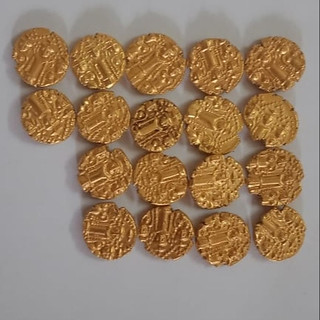 A broken ‘pygg jar' containing 18 gold coins, believed to be dated back to the Madras Presidency of the British era, was unearthed in an agricultural field at Eduvadalapalem village in Koyyalagudem Mandal in Eluru district.
A broken ‘pygg jar' containing 18 gold coins, believed to be dated back to the Madras Presidency of the British era, was unearthed in an agricultural field at Eduvadalapalem village in Koyyalagudem Mandal in Eluru district.
The coins are inscribed with three figures including Lord Venkateswara in the middle. On the other side of the coin, granules of paddy are inscribed. On November 29, Manukonda Tejaswi family unearthed the pygg jar containing the 18 gold coins during the excavation activity carried out for irrigation purpose.
While 17 coins had been recovered from the land owner, one coin was recovered from a worker who was involved in the excavation work on the site. According to an official release, the total weight of the 18 gold coins was 61 gm, each weighing at least three grams.
Archaeology and Museums Assistant Director (Rajamahendravaram) K. Timmaraju said the coins were known as ‘Three Pagoda coins' minted by the Madras Presidency during the period between 1740 and 1805 AD. The three figures on the coins are Lord Venkateswara, Alivelu and Padmavathi. However, a detailed study was required to trace its history, he said.
Found via The Explorator newsletter. To subscribe to Explorator, send a blank email message to: explorator+subscribe@groups.io. -Editor
To read the complete article, see:
Broken ‘pygg jar' with 18 gold coins unearthed in Eluru district of Andhra Pradesh
(https://www.thehindu.com/news/national/andhra-pradesh/broken-pygg-jar-with-18-gold-coins-unearthed-in-eluru-district-of-andhra-pradesh/article66218821.ece)
NORWEGIAN NUMISMATIC ASSOCIATION SCHIVE MEDAL
The Norwegian Numismatic Association Schive Medal has been awarded to author Jan Olav Aamlid. -Editor
Jan Olav Aamlid, world renowned numismatist and longtime resident of Pattaya was presented with the most distinguished Schive Medal by the Norwegian Numismatic Association in recognition of his book Siam Specimen Banknotes First Series
published in Pattaya in December 2021.
On presenting the highly revered award on Nov 18, President Kjetil Kvist of the Schive Committee said, Throughout a lifetime and counting, this year's winner has had a living commitment to coins and banknotes. He has been particularly concerned with numismatics from his adopted fatherland, and is recognized as a resource person in the field.
The Schive medal is a reward medal for amateur numismatists founded by the Norwegian Numismatic Association (NNF) in February 1947. The Schive medal was a gift from medalist Halfdan Rui to the NNF with the aim of stimulating scientific work in the association.
The Schive medal was engraved by Halfdan Rui in 1947, and the portrait of Claudius Jacob Schive is also modeled by Rui. The portrait is placed on the front, and around it is written: TOLDINSP. CLAUDIUS IACOB SCHIVE 1792-1878. On the back it says at the top: From the Norwegian Numismatic Association and at the bottom: For amateur scientific work. In between there is space to engrave the recipient's name and the year of the award.
The Schive medal is 35 mm in diameter and is awarded without a ribbon. The recipient receives a 15 mm miniature with a green ribbon, which is worn on all public holidays in associations as well as summer meetings and Christmas parties. The medal is normally awarded in silver and bronze, but may exceptionally be awarded in gold. No one has yet received the gold medal.
On receiving the most prestigious Schive medal, a delighted Jan Olav said, I am humbled on receiving this most significant award. I am proud to be one of only 10 well-known numismatists in the world to receive this recognition.
I have dedicated most of my life researching about banknotes, coins and medals from all over the world. But my biggest passion is for Thai banknotes and coins. Hence, I wrote this first book Siam Specimen Banknotes First Series
and am now doing research to write the second book to be called Siam Specimen Banknotes Second Series
.
To read the complete article, see:
Jan Olav Aamlid awarded the Schive Medal by the Norwegian Numismatic Association
(https://www.pattayamail.com/pattayamail/jan-olav-aamlid-awarded-the-schive-medal-by-the-norwegian-numismatic-association-417878)
To read the earlier E-Sylum article, see:
NEW BOOK: SIAM SPECIMEN BANKNOTES
(https://www.coinbooks.org/v25/esylum_v25n22a06.html)
HISTORY OF THE AMERICAN CASH REGISTER
A CoinWeek article by Tyler Rossi delves into the history of the classic cash register, the temporary homes of most coins as they wend their way through circulation. Here's an excerpt - see the complete article online. -Editor
If the store owner wasn't careful about who they hired, they could incur dramatic financial losses due to theft. One such businessman suffering from dishonest staff members was James J. Ritty, owner of the Pony House Restaurant in Dayton, Ohio. The story goes that inspiration struck Ritty when returning to America on an Atlantic steamship in 1878. If a machine could count the revolutions of a ship's propeller, then a similar mechanism could be used to count the money coming into his business. Shortly thereafter, Ritty partnered with his brother John to design and create what they called a cash register
.
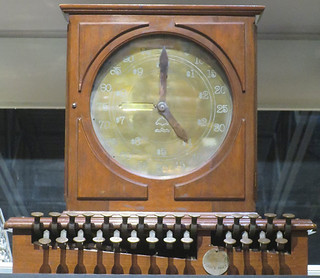 While quite unusual looking, their first prototype included a large circular clocklike face above a single row of keys used to enter the sales price. Two sets of keys–one for cents (ascending in units of five) from five to 95 cents and dollars from $1 to $9–were located below the dial. The machine measured 22 x 14 x 20 inches or 55.88 cm x 35.56 cm x 50.8 cm.
While quite unusual looking, their first prototype included a large circular clocklike face above a single row of keys used to enter the sales price. Two sets of keys–one for cents (ascending in units of five) from five to 95 cents and dollars from $1 to $9–were located below the dial. The machine measured 22 x 14 x 20 inches or 55.88 cm x 35.56 cm x 50.8 cm.
However, Ritty's Dial, their first machine, did not actually include a cash tray. Instead, it was actually a sales recorder. Later, the brothers upgraded their device slightly, and in 1879 filed a patent for the new Incorruptible Cashier
. After patenting the device, Ritty opened the new Cash Register and Indicator Company in Dayton in order to manufacture his new machines. It was then that a certain John H. Patterson, who owned three coal mines and a number of stores, purchased two of Ritty's first machines for $100 per machine (roughly $3,040 adjusted for inflation). According to Patterson, despite selling around $50,000 of merchandise annually (over $1.49 million adjusted for inflation), he was losing most if not all of it to thieving employees. After noticing that a clerk did not enter a sale into the store ledger around the same time, he received an advertisement from the Cash Register and Indicator Company. Notwithstanding his surprise at the machines' low quality, Patterson was surprised at how large an effect they had on his staff. In fact, he claimed to have recorded a $6,000 ($178,807 adjusted for inflation) profit only one year after acquiring the machines.
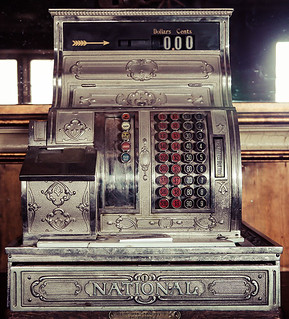 However, being unable to manage the operations of both his salon and the new company, Ritty sold both the Cash Register and Indicator Company as well as the patent to his machine to Jacob H. Eckert of Cincinnati in 1881. This china and glassware salesman incorporated the company under a new name, National Manufacturing Company.
However, being unable to manage the operations of both his salon and the new company, Ritty sold both the Cash Register and Indicator Company as well as the patent to his machine to Jacob H. Eckert of Cincinnati in 1881. This china and glassware salesman incorporated the company under a new name, National Manufacturing Company.
Unlike the early wood types, many of the registers from this period were made from cast brass, and quickly became highly elaborate. Depending on what look the store owner wanted, they could order models made from cast-iron, wood, and metal, with finishes of polished brass, nickel plate, antiqued copper, paint, and silver and gold plate.
At one point, due to the popularity of the brass models, the NRC Company operated one of the world's largest brass foundries.
The drawers in these new machines would have been used to hold a large variety of coins.
To read the complete article, see:
Ka-Ching! A Brief History of the American Cash Register
(https://coinweek.com/education/numismatic-history/ka-ching-a-brief-history-of-the-american-cash-register/)
HISTORY OF THE SAFE DEPOSIT BOX
Meanwhile, the folks at The Hustle dive into the economics of the safe deposit box business, the place where so many coin collections reside. -Editor
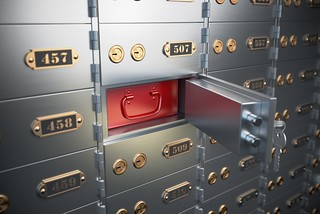 Over the years, safe deposit boxes have become iconic — a staple not only of the banking industry but also of heist movies and spy flicks. Inside Man, The Dark Knight, Casino, and The Da Vinci Code all feature pivotal safe deposit box scenes.
Over the years, safe deposit boxes have become iconic — a staple not only of the banking industry but also of heist movies and spy flicks. Inside Man, The Dark Knight, Casino, and The Da Vinci Code all feature pivotal safe deposit box scenes.
In Hollywood, safe deposit boxes are so prominent, in fact, that it's easy to miss the seismic changes racking the industry: In the wake of the 2008 financial crisis, big banks have quietly abandoned the safe-deposit business.
Both HSBC and Barclays have shuttered their safe-deposit services in many countries, and Capital One joined them in 2016. Most recently, this past September, JPMorgan Chase announced it was phasing out its safe deposit boxes, too. In the coming decade, other major banks seem likely to join them.
The rise of the safe deposit box
 The Civil War was just days away when a New York businessman named Francis Jenks stumbled on an idea that would change the face of the banking industry.
The Civil War was just days away when a New York businessman named Francis Jenks stumbled on an idea that would change the face of the banking industry.
In March 1861, while on a trip to England, Jenks — the moneyed son of a Harvard professor — began to wonder what he was supposed to do with his valuables while he was out of town.
He decided to create a company that would store items for New York's fashionable inhabitants,
who wanted to, say, decamp to Europe for the summer.
Rather than worry about burglaries, Jenks suggested that the urban elite store their books, wills, jewelry, tea sets, and silver with him.
He opened a massive, marble building in lower Manhattan, complete with a thick steel vault. Inside, he offered 500 safe deposit boxes to customers.
To ensure the safety of the boxes, Jenks required two keys to unlock a box: one key for the customer and one key for his employees. Guards armed with muskets stood in front of the building at 146 Broadway through the night.
He called it the Safe Deposit Company of New York.
It was the first company of its kind — and as the Civil War broke out, demand soared. Bold-faced names like the Vanderbilts, the Guggenheims, the Roosevelts, and more began storing their valuables with Jenks. Hetty Green, the millionaire businesswoman, maintained a private vault so big that it could fit a desk inside of it.
It was such a success that copycat safe deposit box companies began proliferating across the US, with names like the Mercantile Safe Deposit Company and the Lincoln Safe Deposit Company.
While the first safe-deposit companies were stand-alone organizations, dedicated solely to safekeeping, major banks soon got involved. By the early 20th century, nearly every bank in America had a safe-deposit arm.
To read the complete article, see:
The quiet disappearance of the safe deposit box
(https://link.thehustle.co/view/5f3bcd6c2c81bf6314597294hsccy.anh8/dabe3bb1)
LOOSE CHANGE: DECEMBER 4, 2022
Here are some additional items in the media this week that may be of interest. -Editor
The Visual Capitalist published a graphic about the security features of U.S. paper money. -Editor
There are 6 key features that identify real bills and protect the falsification of American money.
• Serial Numbers & EURion Constellation
The most basic form of security on an $100 bill is the serial number. Every bill has a unique number to record data on its production and keep track of how many individual bills are in circulation.
The EURion constellation is star-like grouping of yellow rings near the serial number. It is only detectable by imaging software.
• Color Changing Ink
This ink changes color at different angles thanks to small metallic flakes within the ink itself. The $100 bill, like all other paper bills in the U.S., has its value denoted in color changing ink on the bottom right-hand corner; unlike other bills, it also features a liberty bell image using the ink.
To read the complete article, see:
Visualized: The Security Features of American Money
(https://www.visualcapitalist.com/security-features-american-money/)
Leon Saryan passed along this non-numismatic but nonetheless interesting item about the discovery of an ancient amulet. Thanks, -Editor
 Students on a field trip hosted by the Israel Antiquities Authority (IAA) in Azor, five miles southeast of Tel Aviv, witnessed archaeology in action when the group's leader Gilad Stern happened upon a 3,000-year-old amulet.
Students on a field trip hosted by the Israel Antiquities Authority (IAA) in Azor, five miles southeast of Tel Aviv, witnessed archaeology in action when the group's leader Gilad Stern happened upon a 3,000-year-old amulet.
Stern was guiding eighth grade students on the IAA's third annual expedition, educating them about archaeological finds around Azor and beyond, when he saw what first looked like a lost toy on the ground. An inner voice said to me, ‘Pick it up and turn it over,'
Stern told the Jerusalem Post. I was astonished: it was a scarab with a clearly incised scene, the dream of every amateur archaeologist. The pupils were really excited!
To read the complete article, see:
A Group of Eighth-Graders on a Field Trip Near Tel Aviv Stumbled Upon a 3,000-Year-Old Sacred Egyptian Amulet
(https://news.artnet.com/art-world/student-field-trip-egyptian-amulet-israel-antiquities-authority-2221001)
Greg Cohen passed along this New York Times article about an emerald recovered from the wreck of the Atocha. Nice companion to the ring we discussed last week from the wreck of the SS Central America. -Editor
 For years, Mitzi Perdue looked down at her hand and saw history.
For years, Mitzi Perdue looked down at her hand and saw history.
The emerald stone on her ring finger told a story stretching back nearly four centuries, to the sinking of a Spanish galleon near the Florida Keys in 1622 and a decades-long effort of a colorful undersea treasure hunter named Mel Fisher to retrieve its payload of gold and silver coins, gold nuggets and jewelry.
It reminded her, too, of her late husband, the chicken magnate Frank Perdue, who received a share of the bounty in return for his investment in Mr. Fisher's search.
Now, 400 years after the Nuestra Señora de Atocha sank in a hurricane, Ms. Perdue, 81, is putting the emerald up for auction on Wednesday at Sotheby's in New York City. All proceeds from the sale of the ring, which Sotheby's says has an estimated value of $50,000 to $70,000, will be donated to support humanitarian efforts in Ukraine, prompted by Ms. Perdue's visit there this year after the Russian invasion.
To read the complete article, see:
Owner Parts With Rare Emerald From 1622 Shipwreck to Help Ukraine
(https://www.nytimes.com/2022/12/03/us/emerald-auction-perdue.html)
To read the earlier E-Sylum article, see:
NUMISMATIC NUGGETS: NOVEMBER 27, 2022 : SS Central America Gold Ring
(https://www.coinbooks.org/v25/esylum_v25n48a21.html)
HOSPITAL PATIENT'S BELLYACHE: 187 COINS
Kavan Ratnatunga passed along this video from The Indian Express about different kind of coin collector - a hospital patient with 187 coins in his stomach. Thanks. You can't make this stuff up. -Editor
On November 29, doctors in Bagalkot, Karnataka, retrieved 187 coins from a man's stomach, as per ANI report. His relatives brought him to Hanagal Shree Kumareshwar Hospital when he complained of stomach pain. The doctors took his X-ray and did an endoscopy, before removing the coins.
To watch the video, see:
Karnataka: After Man Complains Of Stomach Ache, Doctors Remove 187 Coins The Patient Swallowed
(https://www.youtube.com/watch?v=qhiT3V8ebAI)




